- You are here:
- Home »
- Archive: October, 2025
Archive Monthly Archives: October 2025

Digital Marketing for Authors Guide: Boost Book Sales Fast
Did you know that over 80 percent of self-published authors struggle to sell even 100 books? Reaching the right readers takes more than just writing talent. Success as an author comes down to building a powerful brand and using modern marketing strategies that actually work. Whether you’re looking to grow your audience or turn your passion into steady book sales, these proven steps guide you toward real and measurable results.
Table of Contents
- Step 1: Define Your Author Brand And Target Audience
- Step 2: Build Automated Email Sequences For Readers
- Step 3: Leverage Social Media And Content Platforms
- Step 4: Utilize AI Tools To Streamline Marketing Tasks
- Step 5: Measure Campaign Results And Optimize Strategies
Quick Summary
| Key Point | Explanation |
|---|---|
| 1. Define Your Author Brand | Clearly identify your unique storytelling voice and ideal readers to tailor your marketing efforts. |
| 2. Build Engaging Email Sequences | Create automated email sequences to maintain reader interest and provide them with valuable content. |
| 3. Select Effective Social Media Platforms | Focus on 2-3 platforms where your target audience is most active to boost engagement. |
| 4. Utilize AI Tools for Efficiency | Streamline your marketing tasks with AI tools to save time and enhance content creation. |
| 5. Measure and Optimize Strategies | Regularly analyze marketing metrics to improve your strategies and connect with your readers effectively. |
Step 1: Define Your Author Brand and Target Audience
In this crucial first step, you will craft a strategic roadmap that transforms your writing career by clearly identifying who you are as an author and exactly who will read your books. According to Harvard Business School, identifying your target audience is essential for tailoring marketing strategies that meet specific consumer preferences.
Starting your author brand journey means understanding your unique storytelling voice and the specific readers who will connect most deeply with your work. Ask yourself: What makes my writing different? What themes or genres define my storytelling? What emotional experience do I want readers to have?
To define your target audience, create a detailed reader persona. Go beyond basic demographics like age and gender. Consider deeper characteristics like reading habits, lifestyle preferences, emotional triggers, and specific interests that align with your book’s themes. Nebraska Library Commission suggests that focusing on a specific audience ensures your marketing efforts are directed towards those most likely to engage.
Your reader persona might look like this: A 35-45 year old professional who loves psychological thrillers, enjoys complex character development, and seeks escapist entertainment after long workdays. By getting this specific, you can craft marketing messages that speak directly to their desires and pain points.
Pro Tip: Don’t try to appeal to everyone. The most successful authors know their niche and speak directly to that audience.
Next, you will align your author brand visuals and messaging with this target reader profile to create a cohesive marketing strategy that attracts and retains your ideal readers.
Step 2: Build Automated Email Sequences for Readers
In this step, you will learn how to create powerful automated email sequences that keep your readers engaged and excited about your books. According to BAIPA, implementing autoresponder series enables authors to maintain consistent communication with readers, providing timely updates and fostering engagement.
Start by mapping out a strategic email sequence that takes readers on a journey. Your sequence should include a welcome email, content that provides value, and periodic updates about your books or writing process. Fund Journalism suggests that automated email series can build reader loyalty by delivering relevant content over time.
Design your email sequence with these key components:
- Welcome email introducing yourself and your writing
- Behind the scenes content about your book writing process
- Exclusive excerpts or sneak peeks of upcoming work
- Personal stories that connect readers to your author brand
- Periodic book launch announcements and special offers
Choose an email marketing platform that allows automation and segmentation. This will help you track reader interactions and customize your approach based on their interests and engagement levels.

Pro Tip: Aim for quality over quantity. Send emails that truly provide value rather than bombarding readers with frequent communications.
In the next section, you will learn how to optimize these email sequences for maximum reader engagement and book sales.
Step 3: Leverage Social Media and Content Platforms
In this step, you will transform your social media presence into a powerful book marketing engine that connects directly with potential readers. Pressbooks highlights that utilizing social media platforms allows authors to reach targeted audiences, engage with readers, and build brand awareness through consistent content sharing.
Select 2-3 social media platforms where your target readers are most active. For fiction writers, this might mean Instagram for visual storytelling, Twitter for quick updates, and Facebook for community building. Apps confirms that social media marketing enables direct interaction with the digital audience, facilitating real-time engagement and feedback.
Create a content strategy that mixes personal insights, writing progress, book teasers, and reader interaction. Your content should feel authentic and give readers a peek behind the curtain of your writing world. Share:
- Writing workspace snapshots
- Character development insights
- Book research background
- Short story excerpts
- Reader Q&A sessions
Consistent posting is key. Develop a content calendar that keeps you accountable and helps you maintain a steady stream of engaging posts that reflect your author brand.
Pro Tip: Quality trumps quantity. Focus on creating meaningful connections rather than chasing follower numbers.
In the next section, you will learn how to track and optimize your social media efforts for maximum reader engagement.
Step 4: Utilize AI Tools to Streamline Marketing Tasks
In this step, you will discover how artificial intelligence can transform your marketing workflow and save precious time for writing. Writer Response Theory reveals that AI writing and text generation tools can assist in creating SEO-optimized content, enhancing online visibility and reducing manual effort.
AI tools offer incredible opportunities for authors to automate and optimize marketing tasks. EDIIGOA confirms that digital tools and platforms support entrepreneurs in executing effective marketing strategies and managing brand promotion.
Explore AI tools for these key marketing areas:
- Content creation and blog post drafting
- Social media post generation
- Email subject line optimization
- Book description and blurb writing
- Audience targeting and segmentation
- Keyword research for book metadata
Start by identifying repetitive marketing tasks that consume significant time. Choose AI tools that integrate smoothly with your existing workflow and provide clear value. Experiment with different platforms to find the most intuitive and effective solutions for your specific author brand.
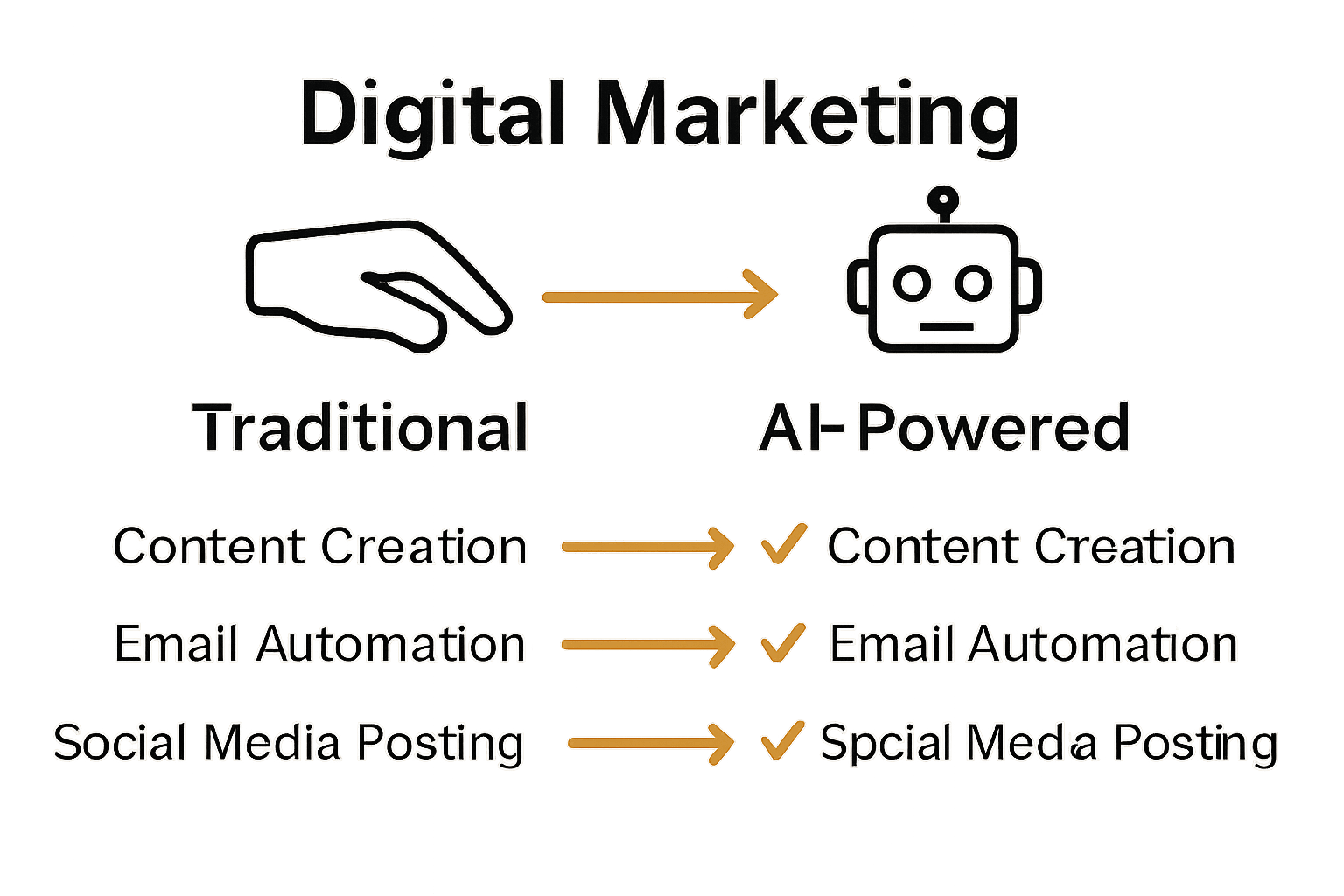
Pro Tip: Always review and personalize AI generated content. Use these tools as assistants not replacements for your unique voice.
In the next section, you will learn how to measure and analyze your marketing efforts to continually improve your book sales strategy.
Step 5: Measure Campaign Results and Optimize Strategies
In this final step, you will transform raw marketing data into actionable insights that continuously improve your book sales strategy. Pressbooks reveals that analyzing customer behavior and preferences through data insights allows for the optimization of marketing efforts and personalization of strategies.
EDIIGOA confirms the importance of setting specific, measurable goals and utilizing digital tools to assess marketing performance and make informed strategic decisions.
Track these critical marketing metrics for your author brand:
- Book sales conversion rates
- Email open and click through rates
- Social media engagement percentages
- Website traffic from marketing campaigns
- Reader interaction and feedback
- Ad spend versus book revenue
Use analytics tools that provide comprehensive insights into your marketing performance. Look for patterns in reader behavior. Which content generates the most engagement? What times of day do your posts perform best? Which marketing channels drive the most book sales?
Pro Tip: Review your metrics monthly. Small consistent improvements compound into significant results over time.
By systematically measuring and refining your approach, you will continuously enhance your marketing strategy and connect more effectively with your ideal readers.
Here’s a summary comparing each step of the author book marketing strategy:
| Step | Main Focus | Key Activities |
|---|---|---|
| Define Your Author Brand and Target Audience | Identify brand and target readers | Create reader personas Clarify author voice Align brand messaging |
| Build Automated Email Sequences | Engage readers via email | Create welcome series Share exclusive content Announce new books |
| Leverage Social Media and Content Platforms | Grow audience and interaction | Select platforms Share behind-the-scenes Host Q&A sessions |
| Utilize AI Tools to Streamline Marketing Tasks | Automate and save time | Use AI for content Automate emails Optimize book blurbs |
| Measure Campaign Results and Optimize Strategies | Improve marketing performance | Track key metrics Analyze engagement Refine strategies |
Unlock Your Author Brand and Boost Book Sales Today
Struggling to define your unique author brand or build email sequences that truly engage readers Can you imagine having AI tools at your fingertips to cut hours of marketing work while still connecting deeply with your ideal audience This guide highlights these exact challenges and goals many authors face when trying to grow loyal readers and increase book sales fast
At DigitalMarketingAuthors.com, founded by 13x #1 Amazon bestselling author C T Mitchell, we specialize in helping authors like you master every step from crafting magnetic email sequences to leveraging AI-powered strategies that save time and amplify your reach
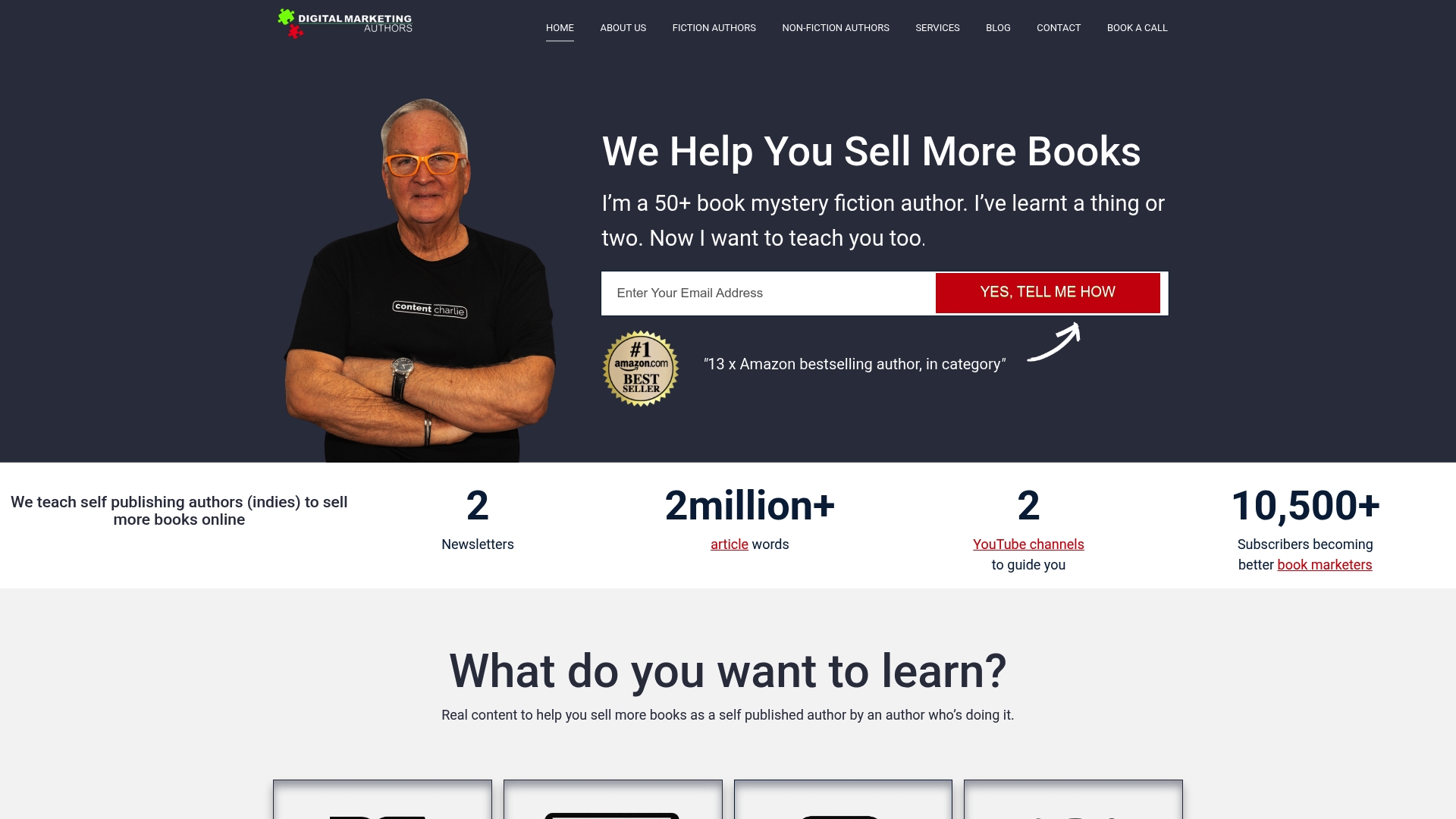
Start turning your writing passion into a profitable author brand now by exploring proven systems that automate book marketing without relying on luck or big publishers Visit DigitalMarketingAuthors.com today to join a community where indie authors grow reader loyalty, improve email engagement, and optimize social media impact. Your readers are waiting and success is within reach.
Frequently Asked Questions
How can I define my author brand and target audience effectively?
Start by identifying your unique writing style and the specific themes you explore. Create a detailed reader persona that includes not only demographics but also reading habits and emotional triggers to tailor your marketing messages accordingly.
What should be included in my automated email sequences for readers?
Your automated email sequences should include a welcome message, valuable content, behind-the-scenes insights, and updates on your books. Aim to engage your readers regularly, ideally with a sequence that evolves over four to six weeks.
How can I use social media to boost my book sales?
Select 2-3 social media platforms where your target readers are most active, and share engaging content like writing progress updates and personal insights. Create a content calendar to ensure you post consistently, helping you build connections and followers over time.
What AI tools can I use to streamline my marketing tasks?
Explore AI tools for automating tasks like content creation, social media post generation, and email optimization. Start by identifying repetitive tasks that consume time and test tools that can help you improve efficiency and save hours each week.
How do I measure the success of my digital marketing campaigns?
Track critical metrics like book sales conversion rates, email open rates, and social media engagement percentages. Regularly analyze these metrics, aiming for monthly reviews to identify trends and refine your strategies for better results.
How can I optimize my strategies to continuously improve book sales?
By systematically measuring your marketing efforts and analyzing reader behavior, you can identify what’s working and what isn’t. Set aside time each month to evaluate your campaigns, make necessary adjustments, and implement changes that enhance engagement and sales.
Recommended

Book Marketing Trends in 2025: Complete Guide
Nearly 80 percent of bestselling books in 2024 owed their rise to social media buzz and direct reader engagement. Authors who once relied on traditional marketing are now seeing dramatic shifts in how books reach audiences. The surge of BookTok, AI-powered promotion tools, and targeted community building has made creative, personal connection the new standard for grabbing attention and driving book sales.
Table of Contents
- Defining Book Marketing Trends for 2025
- AI Tools Revolutionizing Author Promotion
- Email and Automation Strategies for Authors
- Influencer Partnerships and Community Building
- Global Reach and Localization Strategies
- Common Mistakes and Emerging Risks to Avoid
Key Takeaways
| Point | Details |
|---|---|
| Community Engagement | Authors are focusing on building intimate reader communities through platforms like Facebook Groups and BookTok, enhancing direct interactions. |
| Short-Form Video Dominance | Platforms such as TikTok and Instagram Reels are primary channels for book discovery, making engaging video content essential for marketing. |
| AI Empowerment | AI tools are revolutionizing marketing by enabling personalized content and optimizing promotional strategies for diverse platforms. |
| Strategic Global Marketing | Authors are adopting cultural localization strategies to tailor marketing efforts to diverse reader preferences around the world. |
Defining Book Marketing Trends for 2025
The book marketing landscape in 2025 is transforming dramatically, driven by community engagement and digital storytelling strategies that connect authors directly with readers. According to research from LinkedIn, authors are shifting away from traditional broad marketing approaches toward more targeted, relationship-driven promotion techniques.
Key book marketing trends emerging in 2025 include:
- Community-Driven Social Media: Authors are building intimate reader communities through targeted platforms like Facebook Groups, Discord servers, and niche BookTok circles
- Short-Form Video Content: Platforms such as TikTok, Instagram Reels, and YouTube Shorts are becoming primary book discovery and sales channels
- Direct Reader Interaction: Leveraging smaller, highly engaged audience segments instead of chasing massive, impersonal followings
The #BookTok phenomenon continues to demonstrate immense power, with social media video content significantly influencing global bestseller lists. Writers who master authentic, engaging short-form video storytelling will have substantial competitive advantages in capturing reader attention and driving book sales.
For more insights into building sustainable book marketing strategies, check out our smart marketing for writers guide.
Here’s a comparison of leading book marketing trends for 2025:
| Trend | Main Platforms | Key Benefits |
|---|---|---|
| Community-Driven Social Media | Facebook Groups Discord BookTok circles |
Intimate reader groups Direct engagement |
| Short-Form Video Content | TikTok Instagram Reels YouTube Shorts |
High visibility Quick promotion |
| Direct Reader Interaction | Newsletters Author chats Private online events |
Deeper connections Loyal audiences |
| AI Personalization | Custom email tools AI content generators |
Tailored messages Efficient automation |
| Influencer & Community Builds | BookTok Virtual KOL platforms |
Viral reach Trusted recommendations |
AI Tools Revolutionizing Author Promotion
Artificial Intelligence is dramatically transforming author promotion strategies in 2025, offering unprecedented opportunities for personalized marketing and content optimization. According to research from Adobe, AI agents are enabling hyper-targeted marketing experiences that adapt dynamically to different user interactions and promotional channels.
Key AI-powered tools revolutionizing author promotion include:
- Personalized Content Customization: AI systems can tailor marketing materials based on specific user demographics and engagement patterns
- Advanced Writing Assistance: AI strategies for book marketing now include context-aware feedback tools that preserve an author’s unique voice
- Multi-Channel Optimization: AI agents can create targeted content variations for different platforms like TikTok, search results, and social media
Research from Grammarly highlights emerging AI writing assistance technologies, including features like Citation Finder and Reader Reactions. These tools not only enhance writing quality but also provide strategic insights for authors looking to refine their promotional content and connect more effectively with their target audience.
Email and Automation Strategies for Authors
Email marketing is undergoing a revolutionary transformation in 2025, with AI-powered automation becoming the cornerstone of strategic author communication. According to research from Adobe, AI agents can now recommend and implement sophisticated marketing improvements, enabling authors to create more targeted and responsive email campaigns.
Key email automation strategies for authors include:
- Intelligent Segmentation: Automatically categorize readers based on engagement, reading preferences, and interaction history
- Personalized Content Triggers: Develop dynamic email sequences that adapt to individual reader behaviors
- Performance Optimization: Leverage AI tools to analyze and enhance email open rates, click-throughs, and conversion metrics

Advanced tools like author email strategy platforms now integrate AI-powered content generation and refinement. Research from Grammarly highlights emerging technologies such as AI Chat and Expert Review, which can streamline the process of creating compelling email marketing content that resonates with specific reader segments.
Influencer Partnerships and Community Building
Book marketing in 2025 is revolutionizing how authors connect with readers through strategic community building and innovative influencer partnerships. According to research from LinkedIn, authors are now focusing on creating intimate reader communities across platforms like Facebook Groups, Discord servers, and niche BookTok circles that facilitate direct and meaningful interactions.
Key strategies for effective community and influencer engagement include:
- Targeted Platform Selection: Identify and participate in reader-centric communities aligned with your book’s genre
- Short-Form Video Content: Leverage platforms like TikTok, Instagram Reels, and YouTube Shorts to drive book discovery
- Virtual Influencer Integration: Explore emerging technologies like the GenKOL framework for creating high-quality virtual Key Opinion Leaders
The #BookTok phenomenon demonstrates the power of community-driven marketing, with social media video content now significantly influencing global bestseller lists.
Authors who master building a reader community and create authentic, engaging content will have a substantial competitive advantage in capturing and maintaining reader attention.
Global Reach and Localization Strategies
In 2025, authors are reimagining global book marketing through sophisticated digital strategies that transcend traditional geographical boundaries. According to research from LinkedIn, community-driven social media engagement is enabling authors to build targeted, engaged audiences across diverse cultural landscapes by facilitating direct, nuanced interactions through specialized platforms.
Key strategies for expanding global book marketing reach include:
- Platform Diversification: Leverage niche community platforms like Facebook Groups, Discord servers, and regional BookTok circles
- Cultural Content Customization: Develop region-specific marketing materials that resonate with local reader preferences
- AI-Powered Localization: Utilize advanced tools like the GenKOL framework to create culturally adaptive promotional content
By integrating cross-promotion strategies, authors can now create targeted, linguistically and culturally sensitive marketing campaigns that speak directly to readers worldwide. The emerging landscape of global book marketing is defined by intelligent, adaptable approaches that transform traditional geographic limitations into opportunities for meaningful reader connection.
Common Mistakes and Emerging Risks to Avoid
In 2025, authors face complex digital marketing challenges that demand strategic awareness and ethical navigation. According to research from Axios, professionals are experiencing significant shifts in communication strategies, with a notable decline in traditional social media platforms and an increased need for direct audience engagement.
Key risks and mistakes authors must proactively address include:
- AI Content Overreliance: Avoid generating promotional materials entirely through AI, maintaining authentic storytelling and original voice
- Platform Saturation: Carefully select and diversify marketing channels to prevent diminishing audience engagement
- Ethical AI Implementation: Ensure responsible use of generative technologies while preserving content integrity
Navigating these challenges requires a nuanced approach. Email marketing do’s and don’ts become critical in maintaining audience trust, especially as research from academic sources highlights growing concerns about generative AI’s impact on content credibility. Successful authors will balance technological innovation with genuine, transparent communication strategies that prioritize reader connection over algorithmic manipulation.
Master Book Marketing Trends in 2025 and Boost Your Author Success
Navigating the evolving world of book marketing can feel overwhelming, especially with rising trends like community-driven social media, AI-powered personalization, and short-form video dominating the scene. Are you struggling to build authentic reader connections or unsure how to use AI tools without losing your unique voice? This guide on Book Marketing Trends in 2025 highlights the challenges many authors face today and shows how mastering these strategies is key to standing out in a crowded market.

At DigitalMarketingAuthors.com, we specialize in helping authors like you overcome these obstacles by teaching proven digital marketing, email automation, and AI strategies that create loyal reader communities and accelerate book sales. Discover how to craft magnetic email campaigns, make the most of short-form video platforms, and automate your marketing efforts without losing authenticity. Don’t wait to transform your author brand—visit DigitalMarketingAuthors.com and explore our expert insights including smart marketing for writers and effective author email strategy to start marketing smarter and selling faster today.
Frequently Asked Questions
What are the key book marketing trends for 2025?
The major trends include community-driven social media engagement, the rise of short-form video content, direct reader interactions, AI personalization in marketing, and the use of influencer partnerships.
How can authors effectively use short-form video content to promote their books?
Authors can utilize platforms like TikTok, Instagram Reels, and YouTube Shorts to create engaging videos that showcase their books. This content can drive book discovery and attract potential readers through authentic storytelling and creativity.
What role does AI play in book marketing strategies for 2025?
AI is instrumental in personalizing content, optimizing email marketing campaigns, and aiding in writing assistance. It enables authors to reach targeted audiences more efficiently by adapting marketing materials based on user interactions and preferences.
How can authors build and engage with reader communities?
Authors can build reader communities by utilizing platforms like Facebook Groups, Discord, and BookTok. Engaging directly through these channels fosters connections and encourages interaction, allowing authors to understand their audience better and promote their work effectively.
Recommended

7 Best Marketing Channels for Authors to Grow Readership
Did you know that over 70 percent of readers say they discover new books through direct online engagement with authors? Reaching readers has never been more personal or powerful. As book buyers crave genuine connections, authors who foster relationships and visibility online can turn casual fans into loyal supporters. From building a buzzing email list to making your Amazon page work harder, proven strategies open doors to greater book sales and lasting reader communities.
Table of Contents
- 1. Build An Engaged Email List For Direct Book Sales
- 2. Use Social Media Platforms To Connect With Readers
- 3. Optimize Amazon Author And Book Pages For Visibility
- 4. Leverage Author Blogs To Share Stories And Updates
- 5. Run Targeted Ads On Facebook And Amazon
- 6. Join Online Communities And Reader Groups
- 7. Harness AI Tools To Automate Marketing Efforts
Quick Summary
| Takeaway | Explanation |
|---|---|
| 1. Build an engaged email list. | An email list provides direct access to interested readers, enhancing book sales. |
| 2. Utilize social media authentically. | Share personal insights to create genuine connections with readers, fostering loyalty. |
| 3. Optimize Amazon pages for visibility. | Enhancing author and book pages improves discoverability and credibility among potential readers. |
| 4. Create compelling blog content. | An author blog can deepen reader relationships by sharing unique stories and insights. |
| 5. Employ targeted advertising. | Use precise targeting in ads on platforms like Facebook and Amazon to reach ideal readers. |
1. Build an Engaged Email List for Direct Book Sales
Building an engaged email list is the powerhouse marketing channel for authors looking to sell books directly to readers. Your email list represents a direct communication line with readers who are already interested in your work.
An email list allows you to bypass traditional publishing barriers and connect straight with your audience. According to research from email list strategies for authors, successful authors understand that email marketing provides unparalleled control over book promotions and reader relationships.
Key Email List Building Strategies:
- Offer free chapters or exclusive short stories as sign-up incentives
- Place email signup links in book front and back matter
- Create compelling opt-in pages that showcase your writing style
- Promote signup links across your social media profiles
The magic happens when you consistently deliver value through your emails. Share behind-the-scenes writing insights, upcoming book previews, and special reader-only deals. This approach transforms subscribers from casual readers into dedicated fans who eagerly anticipate your next book release.
Successful authors recognize that an email list is more than a marketing tool. It is a community builder. By treating subscribers like valued friends and providing genuine, engaging content, you create a loyal readership that supports your entire writing journey.
2. Use Social Media Platforms to Connect with Readers
Social media represents a powerful gateway for authors to build meaningful connections with readers beyond traditional book marketing. By creating an authentic online presence, you can transform casual readers into dedicated fans who eagerly anticipate your next release.
When strategically approached, social platforms become more than promotional tools. They are dynamic spaces for storytelling and community building. According to research from social media marketing for authors, successful authors leverage these platforms to share personal insights and create genuine engagement.
Effective Social Media Strategies for Authors:
- Share behind-the-scenes writing experiences
- Post interactive content like writing progress updates
- Use visual storytelling through images and short videos
- Create polls and questions that invite reader participation
The key is maintaining a consistent brand voice while offering genuine glimpses into your writing world. Readers want to feel connected to you as a person and storyteller. Whether you are sharing your writing challenges, book research insights, or personal reading recommendations, authenticity drives deeper audience connection.
Remember that each social platform offers unique engagement opportunities. Instagram allows visual storytelling. Twitter enables quick interactions. Facebook supports longer community discussions. By understanding each platform’s strengths, you can craft tailored content that resonates with your specific reader demographic.
3. Optimize Amazon Author and Book Pages for Visibility
Your Amazon author and book pages are critical digital real estate that can transform casual browsers into committed readers. Think of these pages as your online storefront where potential readers decide whether to invest their time and money in your work.
Optimizing your Amazon presence goes beyond simply uploading a book. Strategic keyword selection, compelling book descriptions, and a professional author profile can dramatically increase your discoverability. By understanding Amazon keywords for authors, you can dramatically improve your book’s search ranking and visibility.
Key Amazon Optimization Strategies:
- Create a comprehensive and engaging author bio
- Use high-quality professional author headshot
- Write keyword rich book descriptions
- Select precise and relevant book categories
- Include compelling book metadata
Readers are more likely to purchase books from authors who appear professional and credible. Your author page should tell a story about who you are and why readers should trust your work. Include details about your writing background, your unique perspective, and what makes your books special.
Remember that Amazon algorithms favor books with consistent sales, positive reviews, and active author engagement. Encourage your readers to leave honest reviews, update your author page regularly, and link your other books to create a cohesive author brand that attracts and retains reader interest.
4. Leverage Author Blogs to Share Stories and Updates
An author blog is more than a website. It is your personal storytelling platform where readers can dive deep into your writing world and connect with you beyond your books. By creating authentic and engaging blog content, you transform casual readers into dedicated fans who feel personally invested in your journey.
Blogs offer an unparalleled opportunity to showcase your unique voice and build meaningful reader relationships. By following strategies to get your first 1000 blog readers, you can create a powerful platform that attracts and retains reader interest.
Powerful Blog Content Strategies:
- Share behind the scenes writing experiences
- Offer writing process insights
- Discuss book research and inspiration
- Create serialized content related to your books
- Host virtual writing workshops or Q and A sessions
Your blog becomes a bridge between your books and your readers. It allows fans to understand your creative process, peek into your writing life, and feel a genuine connection to your storytelling. Whether you are sharing writing challenges, book research adventures, or personal reflections, each post builds trust and engagement.
Consistent blogging demonstrates your commitment to your craft and provides readers with ongoing reasons to stay connected. Think of your blog as an evolving narrative that complements your published works and invites readers into your creative universe.
5. Run Targeted Ads on Facebook and Amazon
Targeted advertising represents a precision instrument for authors seeking to connect with their ideal readers. Unlike traditional marketing approaches, platforms like Facebook and Amazon allow you to laser focus your book promotions directly to readers most likely to love your work.
Understanding how to craft strategic ads can transform your book marketing from scattered attempts to surgical precision. By exploring social media marketing campaign strategies, authors can dramatically improve their book visibility and reader acquisition.
Strategic Ad Targeting Techniques:
- Select precise demographic interests matching your book genre
- Create visually compelling ad graphics
- Write concise and engaging ad copy
- Use genre specific targeting keywords
- Set realistic budget parameters
- Track and analyze ad performance metrics
Amazon ads work differently from social media ads. On Amazon, you are targeting readers already in a purchasing mindset. Facebook ads allow more creative storytelling and broader audience discovery. Both platforms require understanding your specific reader persona and crafting messages that resonate with their interests.
Successful ad campaigns are not about spending more money but about spending smarter. Start with small budgets, test different approaches, and continuously refine your targeting. Your goal is creating ads that feel less like marketing and more like an invitation to discover an exciting new reading experience.
6. Join Online Communities and Reader Groups
Online reader communities are secret weapon platforms where authors can transform casual readers into dedicated fans. These digital spaces offer unprecedented opportunities to connect directly with readers who share your literary passions and genres.
By understanding how to build reader connections, you can create meaningful relationships that extend far beyond traditional book marketing approaches. These communities are not just about selling books but about creating genuine interactions.
Powerful Community Engagement Strategies:
- Participate authentically without constant self promotion
- Share genuine insights about your writing process
- Ask thoughtful questions to spark discussions
- Offer helpful advice to fellow writers and readers
- Provide value before expecting anything in return
Different platforms offer unique community experiences. Goodreads provides book review spaces. Reddit hosts genre specific discussion groups. BookTok on TikTok offers visual storytelling opportunities. Each platform requires a nuanced approach that respects community norms and genuine interaction.
Remember that successful community engagement is about building relationships. Readers want to connect with real people not walking book advertisements. Show your personality. Share your writing struggles. Celebrate other authors. By creating authentic connections, you transform passive readers into active supporters of your writing journey.
7. Harness AI Tools to Automate Marketing Efforts
Artificial intelligence has transformed author marketing from time consuming manual tasks to streamlined strategic efforts. AI tools now offer authors unprecedented opportunities to work smarter not harder by automating complex marketing processes.
By exploring AI tools for authors, writers can unlock powerful strategies that save time and increase reader engagement. These intelligent technologies act like a personal marketing assistant working around the clock.
AI Marketing Automation Strategies:
- Generate personalized email campaign content
- Analyze reader behavior and preferences
- Create targeted social media posts
- Draft marketing copy and book descriptions
- Segment audience for precise targeting
- Schedule consistent content across platforms
Successful AI integration requires a strategic approach. These tools are not replacements for human creativity but powerful assistants that handle repetitive tasks. Authors can redirect their energy from administrative work to what they do best writing compelling stories.
The future of author marketing is a collaborative dance between human creativity and artificial intelligence. By embracing these technologies thoughtfully, you can create more efficient marketing workflows that reach readers more effectively and allow you to focus on your core passion writing extraordinary books.
Below is a comprehensive table summarizing the key strategies and benefits discussed for authors in the article.
| Strategy | Implementation | Expected Results |
|---|---|---|
| Engaged Email List | Offer free chapters, use signup links in books, promote on social media. | Direct communication, build a loyal reader base. |
| Social Media Platforms | Share personal insights, use visual storytelling, create interactive content. | Build connections, transform casual readers into dedicated fans. |
| Optimize Amazon Pages | Use keyword-rich descriptions, professional profiles, and relevant categories. | Increase discoverability and sales. |
| Author Blogs | Share writing experiences and insights, host online events. | Deepen reader connection, showcase creativity. |
| Targeted Ads | Use demographics, engaging graphics, and specific keywords. | Precise marketing, attract ideal readers. |
| Online Communities | Engage authentically, share insights, ask questions. | Build genuine relationships and reader support. |
| Leverage AI Tools | Automate email, analyze behaviors, schedule content. | Save time, enhance marketing efficiency and engagement. |
Unlock the Power of Proven Marketing Channels to Grow Your Readership
Authors face the challenge of standing out in a crowded market while building a loyal reader base. The article highlights how crucial strategies like building an engaged email list, leveraging social media, optimizing Amazon pages, and using AI tools can transform your book marketing but knowing where to start and how to do this effectively can feel overwhelming. If you want to stop guessing and start applying tested systems that deliver real results with less effort, there is a smarter way.

Discover how DigitalMarketingAuthors.com empowers writers like you with step-by-step digital marketing tactics including magnetic email sequences, AI-powered automation, and reader community growth that align perfectly with the 7 best marketing channels discussed. Don’t let uncertainty slow you down. Join us to learn how to market smarter, sell faster, and scale your readership worldwide. Start taking control of your author brand and unlock your book’s full potential today by visiting DigitalMarketingAuthors.com.
Frequently Asked Questions
How can I effectively build an engaged email list as an author?
Building an engaged email list involves offering incentives like free chapters or exclusive content to entice sign-ups. Create compelling opt-in pages and promote your email sign-up links on your social media to reach a wider audience.
What are the best strategies for using social media to connect with readers?
To effectively use social media, focus on sharing behind-the-scenes content, engaging visuals, and interactive posts that invite reader participation. Aim to maintain a consistent brand voice while posting, creating a personal connection that attracts dedicated fans.
How can I optimize my Amazon author and book pages for better visibility?
Enhance your Amazon presence by writing keyword-rich book descriptions and crafting a comprehensive author bio. Regularly update your author page and encourage readers to leave positive reviews to improve your search ranking.
What content should I include on my author blog to attract more readers?
Share insights into your writing process, book research, and personal stories to create engaging blog content. Focus on offering value through your posts, such as writing tips or updates about your work, to keep readers coming back for more.
How do I run effective targeted ads on platforms like Facebook and Amazon?
Create targeted ads by selecting precise demographic interests that match your book genre and crafting visually compelling graphics. Track the performance of your ads and adjust your approach based on the engagement and reach metrics you observe.
What steps should I take to engage with online communities of readers?
Join online reader communities and participate authentically by sharing insights about your writing process without constant self-promotion. Offer value and ask engaging questions to foster genuine interactions that build lasting relationships with your audience.
Recommended

Digital Marketing Tips for Authors to Boost Book Sales
Over 80 percent of books fail to reach their intended audience, not because of poor writing, but because the right readers never find them. Many authors pour their energy into writing without a clear plan for connection. Targeted book marketing gives your work the best chance to reach the readers who will cherish it. Discover a practical way to focus your efforts and create genuine interest in your books.
Table of Contents
- Step 1: Define Your Ideal Reader Profile And Genre Niche
- Step 2: Build And Optimize An Author Website With Lead Magnets
- Step 3: Create Automated Email Sequences To Nurture Subscribers
- Step 4: Leverage Social Media And AI Tools For Book Promotion
- Step 5: Track Results And Refine Your Digital Marketing Strategy
Quick Summary
| Key Point | Explanation |
|---|---|
| 1. Define your ideal reader profile | Craft a specific reader profile to target your book marketing effectively, boosting reader engagement. |
| 2. Build an optimized author website | Design a professional website with lead magnets to convert casual visitors into dedicated readers. |
| 3. Create automated email sequences | Implement automated emails to nurture subscriber relationships and keep them engaged with your writing. |
| 4. Utilize social media and AI tools | Leverage social media analytics and AI for targeted marketing strategies that connect you with potential readers. |
| 5. Track and refine your marketing strategy | Regularly analyze performance metrics to adapt and improve your book promotion efforts continuously. |
Step 1: Define your ideal reader profile and genre niche
Creating a precise reader profile transforms your book marketing strategy from scattered efforts to targeted precision. By understanding exactly who will connect with your writing, you can craft messages that resonate deeply and attract readers who genuinely want your work.
Start by mapping out demographic and psychographic details. Who are the people most likely to love your book? Consider age range, gender, interests, reading habits, and lifestyle. According to research from NY Book Editors, identifying your ideal reader enables stronger storytelling through tailored language and narrative framing.
Quick profiling steps include analyzing readers of similar books in your genre. Look at Amazon reviews, book club discussions, and reader forums. What themes, character types, and story elements do they consistently praise? What emotional experiences are they seeking?
Your genre niche requires matching your unique storytelling passion with market demand. As Write Atlas suggests, a strong niche statement clarifies your specific audience and the distinctive value you provide.
Pro Tip: Create a detailed reader persona document. Give your ideal reader a name, background, and specific reading preferences. The more vivid and specific your profile, the more effectively you can target your marketing efforts.
By understanding your readers intimately, you transform book marketing from guesswork into a strategic conversation with the exact people most likely to become your loyal fans.
Step 2: Build and optimize an author website with lead magnets
Your author website is your digital storefront where potential readers first discover your literary world and connect with your brand. Creating a professional online presence with strategic lead magnets will transform casual visitors into committed readers and email subscribers.
According to research from My Codeless Website, professional design and compelling copywriting are crucial for author websites. Your site should showcase your unique writing style while offering valuable resources that engage potential readers.
Start by designing a clean professional website that reflects your genre and author personality. Include key elements like an author bio, book previews, and most importantly compelling lead magnets. These free resources can range from chapter excerpts and short stories to writing assessment tools or exclusive content that provides immediate value to your audience.
Create lead magnets specifically tailored to your reader profile. For fiction writers this might mean bonus character backstories. For nonfiction authors this could be a downloadable resource guide related to your book’s topic. The goal is offering something so intriguing that visitors willingly exchange their email address to receive it.
Pro Tip: Ensure your lead magnet delivery system is seamless. Use email marketing platforms that automatically send downloadable resources immediately after someone subscribes. This instant gratification increases the likelihood of engagement.
By strategically designing your website with targeted lead magnets, you transform casual web browsers into potential long term readers and email list subscribers who are genuinely interested in your writing.

Here’s a comparison of key elements for building an effective author website:
| Website Element | Purpose | Example for Fiction | Example for Nonfiction |
|---|---|---|---|
| Author Bio | Build trust & connect | Creative background | Subject matter expert |
| Book Previews | Generate interest | First chapter sneak peek | Downloadable sample chapter |
| Lead Magnets | Grow email list | Bonus character backstory | Topic resource guide |
| Professional Design | Reflect brand & genre | Genre-themed visuals | Clean, informative layout |
| Calls to Action | Encourage engagement | Subscribe for updates | Get your free checklist |
Step 3: Create automated email sequences to nurture subscribers
Automated email sequences transform casual subscribers into dedicated readers by delivering personalized content that builds genuine connections. Think of these sequences as a digital conversation that introduces your writing and keeps readers engaged without constant manual effort.
According to research from Armlin House, leveraging email marketing tools to segment your audience based on preferences enables more personalized communication. This targeted approach significantly increases the likelihood of converting subscribers into book buyers.
Design your email sequence with a strategic arc that mirrors a reader relationship. Start with a welcome email introducing yourself and delivering the promised lead magnet. Follow up with emails that provide value whether through writing insights, behind the scenes glimpses, or exclusive content related to your books.
Consider creating different sequences for different reader segments. Fiction writers might craft sequences that reveal character backstories or writing inspiration. Nonfiction authors could design sequences offering additional research insights or practical tips complementing their book’s themes.
Pro Tip: Space your emails strategically. Avoid overwhelming subscribers with daily messages. A well timed sequence might include a welcome email immediately after signup followed by emails spaced 3 to 7 days apart.
By thoughtfully crafting automated email sequences that provide consistent value, you transform subscribers from passive readers into active fans eagerly anticipating your next literary work.
Step 4: Leverage social media and AI tools for book promotion
Social media and AI tools have revolutionized book marketing by providing authors unprecedented ways to connect directly with potential readers. These powerful technologies enable you to create targeted promotional strategies that reach the right audience at the right time.
According to research from Blue Rose One, social media platforms offer valuable analytics to understand potential readers demographics and interests. By utilizing these insights strategically, you can craft precise marketing approaches that resonate with your ideal audience.
Start by selecting social media platforms where your target readers are most active. For fiction writers this might mean Instagram or TikTok. For nonfiction authors LinkedIn or Twitter could be more effective. Use platform specific features like stories polls and live sessions to create interactive content that builds community around your writing.
AI tools can supercharge your social media strategy by helping generate content ideas analyze audience engagement and even create promotional graphics. These technologies can help you understand which types of posts generate the most interest and optimize your marketing efforts with data driven insights.
Pro Tip: Conduct interactive surveys and polls through social media to directly engage your audience. This approach not only generates content ideas but also helps you understand reading preferences and potential book marketing strategies.
By combining strategic social media engagement with intelligent AI powered tools you transform book promotion from a guessing game into a precise targeted approach that connects you directly with readers who are most likely to love your work.
Step 5: Track results and refine your digital marketing strategy
Tracking and refining your digital marketing strategy transforms guesswork into precision targeting for your book promotion efforts. By systematically analyzing your marketing performance you can continuously improve your approach and maximize book sales.
According to research from Self Publishing Advice, focusing marketing efforts on a specific micro niche ensures that promotional activities resonate with the right readers. This means aligning every aspect of your marketing from book descriptions to social media engagement with your target audience.
Start by identifying key performance metrics that matter most to your book marketing goals. These might include email open rates social media engagement book preview downloads and actual book sales. Use analytics tools provided by platforms like Amazon social media sites and email marketing services to gather comprehensive data about your audience interactions.
Implement a regular review process where you examine these metrics monthly or quarterly. Look for patterns in what content generates the most interest what time of day your audience is most responsive and which platforms deliver the best conversion rates. This data driven approach allows you to make informed decisions about future marketing investments.
Pro Tip: Create a simple tracking spreadsheet that compares different marketing strategies and their corresponding results. This visual representation will help you quickly identify which approaches are most effective and where you should focus your future efforts.
By continuously tracking analyzing and refining your digital marketing strategy you transform book promotion from a static process into a dynamic responsive system that adapts to your readers changing preferences and behaviors.
Unlock Your Book’s Potential with Proven Digital Marketing Strategies
Struggling to transform your digital marketing efforts into real book sales can be frustrating. You know the importance of defining your ideal reader, building an engaging author website, and leveraging AI tools but applying these concepts strategically often feels overwhelming. This article highlights the need for a targeted marketing approach, automated email sequences, and data-driven refinement to reach and grow your loyal reader community.
At DigitalMarketingAuthors.com, we understand these challenges firsthand. Founded by 13x #1 Amazon bestselling author C.T. Mitchell, we specialize in helping indie authors build profitable author brands with step-by-step guidance on automating your book sales and using AI-powered tools to boost your visibility. With our proven systems, you can stop guessing and start marketing smarter, faster, and more effectively.
Looking to turn your marketing efforts into lasting success?

Visit DigitalMarketingAuthors.com today to learn how to craft magnetic email sequences and design a professional author website that converts visitors into loyal readers. Don’t wait until your next book launch — take control of your author brand now and watch your sales grow.
Explore essential strategies to grow your readership and automate your marketing with expert insights at DigitalMarketingAuthors.com. Start building your unstoppable author platform today.
Frequently Asked Questions
How can I identify my ideal reader profile to boost book sales?
Identifying your ideal reader profile helps you target your marketing efforts effectively. Start by analyzing demographic details such as age and interests, and psychographic details like reading habits. Create a detailed reader persona and use it to shape your marketing messages.
What essential elements should my author website include for effective marketing?
Your author website should include a professional author bio, book previews, and compelling lead magnets to attract visitors. Ensure your site visually reflects your genre and includes clear calls to action, prompting visitors to subscribe or engage further. Focus on key elements that reflect your brand and resonate with your audience.
What type of lead magnets can I create to grow my email list?
To grow your email list, offer lead magnets that appeal specifically to your reader profile. Examples include exclusive chapter excerpts, bonus content, or downloadable resources related to your book’s theme. Craft these lead magnets to provide immediate value and encourage visitors to exchange their email addresses for access.
How should I structure my automated email sequences to engage subscribers?
Structure your automated email sequences by starting with a welcome email that introduces yourself and provides the lead magnet. Then, follow up with valuable content over the next few weeks, spacing the emails 3 to 7 days apart. This consistent engagement keeps subscribers interested and helps build a relationship.
What social media strategies can I use to promote my book effectively?
Choose social media platforms where your target readers are active and create engaging content tailored to those platforms. Use interactive features like polls, stories, and live sessions to foster community around your writing. Tailor your posts based on analytics to understand and effectively reach your audience.
How can I track the effectiveness of my digital marketing efforts?
Track your digital marketing effectiveness by identifying key performance metrics like email open rates, social media engagement, and book sales. Regularly review these metrics—monthly or quarterly—to assess which strategies yield the best results, allowing you to refine your marketing approach as needed.
Recommended

What Is Book Marketing Funnel? Complete Overview
Did you know that over 70 percent of book buyers discover titles online before making a purchase? In a crowded marketplace, standing out means more than just writing a great book. Authors face fierce competition for reader attention, which makes a smart marketing strategy essential. By understanding how a book marketing funnel works, you can transform scattered interest into loyal fans and consistent sales.
Table of Contents
- Defining The Book Marketing Funnel
- Stages Of The Book Marketing Funnel
- Types Of Funnels For Authors
- How Book Funnels Drive Sales
- Common Pitfalls And Best Practices
Key Takeaways
| Point | Details |
|---|---|
| Effective Funnel Structure | A book marketing funnel guides readers through stages of awareness, consideration, conversion, and loyalty, ultimately transforming casual browsers into loyal fans. |
| Targeted Engagement | Authors should create personalized content and use strategic touchpoints to build trust and maintain reader interest throughout the funnel. |
| Diverse Funnel Types | Different funnel approaches, such as lead generation, sales, and webinar funnels, can be employed to meet specific marketing goals and foster reader communities. |
| Focus on Best Practices | Key strategies for success include understanding your audience, delivering consistent value, and providing clear calls to action to optimize the reader acquisition process. |
Defining the Book Marketing Funnel
A book marketing funnel is a strategic roadmap that transforms casual browsers into dedicated readers and loyal book buyers. According to research from AuthorMedia, this model systematically guides potential readers through carefully designed stages—from initial awareness to final purchase—by methodically building trust and engagement at each interaction point.
At its core, a book marketing funnel is more than just a sales strategy. As book marketing insights from MarkinBlog indicate, it’s a specialized system that uses books as primary marketing tools to generate leads and drive direct sales. Think of it like a carefully constructed journey where each step is intentionally designed to attract, intrigue, and ultimately convert interested readers into committed fans.
Key characteristics of an effective book marketing funnel include:
- Targeted audience identification
- Strategic content positioning
- Multiple touchpoints for reader engagement
- Clear conversion pathways
- Personalized reader experience
The ultimate goal of a book marketing funnel is not just selling a single book, but creating a sustainable ecosystem where readers become long-term supporters of an author’s work. By understanding and implementing these strategic principles, authors can transform random book discoveries into predictable, repeatable reader acquisition processes.
Stages of the Book Marketing Funnel
The book marketing funnel follows a strategic progression designed to transform potential readers into loyal book buyers. According to research from book marketing insights, this journey can be broken down into three critical stages: Attract, Engage, and Convert. These stages represent a carefully crafted pathway that guides readers from initial discovery to becoming committed fans.
Drawing from Amazon’s marketing research, the funnel expands these stages into four key phases: Awareness, Consideration, Conversion, and Loyalty. In the Awareness stage, authors introduce their book to potential readers through targeted marketing channels. During the Consideration phase, readers become intrigued and begin exploring more about the book and its context. The Conversion stage is where potential readers make the critical decision to purchase, while the Loyalty stage focuses on transforming one-time buyers into long-term supporters.
Key actions within each stage include:
- Awareness Stage
- Creating compelling book descriptions
- Developing targeted social media content
- Utilizing strategic book preview techniques
- Consideration Stage
- Sharing reader reviews and testimonials
- Offering sample chapters
- Demonstrating book’s unique value proposition
- Conversion Stage
- Providing easy purchase options
- Offering limited-time promotions
- Creating clear call-to-action strategies
By understanding and intentionally designing each stage of the book marketing funnel, authors can create a systematic approach to attracting, engaging, and retaining readers.
 This strategic model transforms book marketing from a hit-or-miss endeavor into a predictable, repeatable process of reader acquisition and community building.
This strategic model transforms book marketing from a hit-or-miss endeavor into a predictable, repeatable process of reader acquisition and community building.
Here’s a comparison of the key actions and objectives at each stage of the book marketing funnel:
| Stage | Key Actions | Primary Objective |
|---|---|---|
| Awareness | Book descriptions Social media Book previews |
Capture attention |
| Consideration | Reviews Sample chapters Value proposition |
Build interest & trust |
| Conversion | Easy purchase Promotions Clear call-to-action |
Drive book sales |
| Loyalty | Community building Email engagement Follow-ups |
Create long-term supporters |
Types of Funnels for Authors
Authors have multiple strategic book marketing funnel approaches to connect with potential readers and drive book sales. According to marketing insights from MarkinBlog, these funnels can be categorized into three primary types: lead generation, sales, and webinar funnels, each designed to achieve specific marketing objectives.
Research from AuthorMedia highlights several nuanced funnel strategies that authors can leverage. The free book funnel offers complimentary content to attract readers and collect contact information, creating an initial engagement point. Discount funnels provide time-sensitive price reductions to encourage immediate purchases, while webinar funnels utilize online seminars to deeply engage audiences by discussing book themes, author insights, and related topics.
Key characteristics of different author funnel types include:
- Lead Generation Funnel
- Offers free downloadable content
- Captures reader email addresses
- Builds initial audience relationship
- Sales Funnel
- Direct book purchase pathway
- Minimal friction in buying process
- Clear value proposition
- Webinar Funnel
- Interactive audience engagement
- Demonstrates author expertise
- Soft sell approach to book promotion
By understanding and strategically implementing these diverse funnel approaches, authors can create targeted marketing strategies that not only sell books but also build long-term reader communities and sustainable author platforms.
How Book Funnels Drive Sales
Book funnels transform the traditional book marketing approach by creating a systematic pathway that strategically converts potential readers into paying customers. According to research from AuthorMedia, these funnels drive sales by methodically guiding potential readers through carefully designed stages of awareness, engagement, and conversion, building trust and sustained interest along the way.
The mechanics of sales generation in book funnels revolve around providing incremental value at each interaction point. As insights from MarkinBlog reveal, successful funnels offer valuable content and engaging experiences that nurture leads, dramatically increasing the likelihood of converting prospects into enthusiastic book buyers. This approach goes beyond traditional one-time marketing tactics by creating a comprehensive journey that resonates with readers.
Key strategies for driving sales through book funnels include:
- Creating compelling initial touchpoints
- Offering irresistible lead magnets
- Developing targeted email sequences
- Providing social proof through testimonials
- Implementing strategic pricing and discount mechanisms
Ultimately, book funnels work by transforming casual browsers into committed readers through a carefully orchestrated process of attraction, engagement, and conversion. By understanding and implementing these strategic approaches, authors can create predictable sales systems that turn interested readers into loyal book purchasers and long-term fans.
Common Pitfalls and Best Practices
Book marketing funnels can quickly become ineffective when authors fail to understand their fundamental principles. According to research from AuthorMedia, the most significant pitfalls emerge from neglecting to build genuine trust with readers, failing to engage effectively, and not providing crystal-clear calls to action.
Research from MarkinBlog highlights critical best practices for creating successful book marketing funnels. Audience alignment is crucial – ensuring each funnel stage provides genuine value and speaks directly to reader expectations. Authors must avoid overly complex strategies and instead focus on creating streamlined, intuitive experiences that guide potential readers smoothly from initial discovery to final purchase.
Common Pitfalls to Avoid:
- Neglecting audience research
- Creating generic, impersonal content
- Overwhelming readers with too many steps
- Inconsistent messaging across funnel stages
- Failing to track and optimize performance
Best Practices for Effective Book Funnels:
- Understand your target reader deeply
- Provide consistent, valuable content
- Create clear, compelling calls to action
- Use targeted email sequences
- Continuously test and refine your approach
Successful book marketing funnels are not about manipulation but about creating genuine connections. By focusing on reader needs, delivering consistent value, and maintaining transparency, authors can transform their marketing approach from a sales pitch to a meaningful reader engagement strategy.
Turn Your Book Marketing Funnel Into a Predictable Sales Machine
Struggling to move readers smoothly from discovery to loyal fans Identify the gaps in your funnel stages from Awareness to Loyalty and transform missed opportunities into lasting connections. The article highlights common challenges like unclear calls to action and inconsistent messaging that stop authors from building real trust. You want a system that feels simple yet powerful enough to automate your sales and engagement without overwhelming you.

At DigitalMarketingAuthors.com, we specialize in helping authors master every phase of their book marketing funnel by teaching proven digital marketing, email automation, and AI-powered strategies. Our approach is designed to help you craft magnetic email sequences, create genuine reader engagement, and turn casual browsers into devoted book buyers. Don’t let your hard work go unnoticed. Take control of your funnel today and start growing a loyal reader community that supports your author brand long term. Visit us now at DigitalMarketingAuthors.com to get started on building smarter, faster, and predictable book sales.
Frequently Asked Questions
What is a book marketing funnel?
A book marketing funnel is a strategic roadmap designed to transition casual browsers into dedicated readers and loyal book buyers by guiding them through stages of awareness, engagement, and conversion.
What are the stages of a book marketing funnel?
The stages of a book marketing funnel include Awareness, Consideration, Conversion, and Loyalty, which help authors systematically engage potential readers and build long-term relationships.
How can authors effectively use book funnels to drive sales?
Authors can drive sales by creating compelling initial touchpoints, offering valuable lead magnets, developing targeted email sequences, and providing social proof through testimonials to nurture leads.
What are common pitfalls in creating a book marketing funnel?
Common pitfalls include neglecting audience research, creating generic content, overwhelming readers with too many steps, and inconsistent messaging across funnel stages.
Recommended

7 Smart Social Media Ideas for Writers to Build Loyal Fans
Did you know that readers are nearly twice as likely to engage with authors who share authentic glimpses into their creative world? Building meaningful connections with your audience can turn casual followers into loyal fans. By showcasing your process, encouraging interaction, and celebrating your community, you create a vibrant space where your writing truly comes alive and your readers feel part of every chapter.
Table of Contents
- 1. Share Behind-the-Scenes Writing Processes
- 2. Host Interactive Q&A or Live Reading Sessions
- 3. Use Hashtags to Reach Target Readers
- 4. Run Book Giveaways and Contests
- 5. Collaborate with Other Authors Online
- 6. Share Reader Reviews and Testimonials
- 7. Leverage Visual Content for Storytelling
Quick Summary
| Takeaway | Explanation |
|---|---|
| 1. Share your writing journey | Connect with readers by sharing behind-the-scenes content from your creative process. |
| 2. Host interactive sessions | Engage your audience through live Q&A sessions or readings, fostering a sense of community. |
| 3. Use targeted hashtags | Enhance the visibility of your posts by using relevant and specific hashtags to reach your audience. |
| 4. Run engaging contests | Increase reader engagement through thoughtful book giveaways or contests that encourage participation. |
| 5. Collaborate with fellow authors | Expand your reach by creating authentic partnerships with other writers for mutual support and promotion. |
1. Share Behind-the-Scenes Writing Processes
Revealing your writing journey is more than just marketing. It is a powerful way to transform casual readers into dedicated fans who feel personally connected to your creative process. According to research from public library studies, authors can forge deeper relationships by offering authentic glimpses into their writing world.
Think of your social media platforms as intimate windows into your writing universe. Readers crave genuine storytelling beyond just finished books. By sharing raw, unpolished moments of your creative process, you invite them behind the literary curtain. This might include snapping photos of your chaotic writing desk, recording quick video updates about your current project, or posting handwritten plot outline sketches.
Some strategic behind-the-scenes content ideas include:
- Capturing early morning writing sessions
- Showing research materials and inspiration boards
- Sharing manuscript editing screenshots
- Posting brainstorming notes and draft paragraphs
- Recording short video updates about your writing progress
Research from university press content about author engagement indicates that readers who feel emotionally invested are more likely to become long term supporters. Your transparency transforms followers from passive consumers into active participants in your writing journey.
Practical implementation matters. Use smartphone apps for quick behind-the-scenes captures. Create consistent sharing patterns weekly or biweekly. Authenticity trumps perfection. Readers appreciate seeing the human behind the words.
2. Host Interactive Q&A or Live Reading Sessions
Interactive social media sessions transform passive readers into an engaged community. By opening direct communication channels, authors can build deeper connections that go far beyond traditional book marketing strategies.
When you host live sessions, you create authentic interaction spaces where readers can peek into your creative world. These events break down barriers between writers and audiences, allowing for real time engagement that feels personal and immediate. Research indicates that social media platforms provide unique opportunities for public interaction, enabling authors to connect with diverse communities in meaningful ways.
Practical strategies for hosting compelling interactive sessions include:
- Selecting user friendly platforms like Instagram Live or Facebook Live
- Preparing topic themes or reading segments in advance
- Setting clear expectations about session duration
- Encouraging audience questions and participation
- Planning technical aspects like lighting and sound quality
Your live sessions can take multiple formats. Read short story excerpts. Discuss writing inspirations. Answer reader questions about your creative process. According to engagement research from how to understand digital marketing for writers, these interactive moments significantly enhance audience connection.
Pro tips for success: practice your technical setup beforehand, promote the event in advance across your social platforms, and maintain an approachable authentic energy. Most importantly, treat these sessions as conversations not performances. Your genuine enthusiasm will shine through and attract loyal readers who feel personally connected to your writing journey.
3. Use Hashtags to Reach Target Readers
Hashtags are your secret weapon for connecting with readers who are actively seeking content like yours. They transform your social media posts from isolated updates into discoverable conversations that can reach potential fans across different platforms.
Strategic hashtag usage goes beyond simply adding popular tags. It is about creating targeted connections with readers who are genuinely interested in your specific writing genre or style. Research indicates that appropriate hashtags can dramatically increase the visibility of your content, helping you reach audiences that might otherwise never discover your work.
Effective hashtag strategies include:
- Using genre specific tags (#MysteryBooks #RomanceReads)
- Incorporating reading community tags (#BookTok #BookWorm)
- Creating unique tags for your book series or writing brand
- Researching trending hashtags in your specific writing niche
- Mixing popular and niche tags for maximum reach
Understanding hashtag dynamics requires ongoing learning. Some platforms like Instagram allow up to 30 hashtags, while Twitter works best with 1 to 2 carefully chosen tags. Check social media strategies for fiction authors to understand platform specific nuances.
Remember that quality trumps quantity. Choose hashtags that truly represent your content and connect you with readers who will be genuinely interested in your writing. Think of hashtags as bridges connecting your work to readers searching for exactly the kind of stories you create.
4. Run Book Giveaways and Contests
Book giveaways are more than just free promotional tools. They are powerful engagement engines that transform casual readers into dedicated fans who feel personally connected to your writing journey.
Strategic contest design can dramatically amplify your social media presence and reader interaction. When executed thoughtfully, giveaways create excitement, generate word of mouth marketing, and build anticipation for your upcoming works. Research shows that offering unique prizes like signed copies or exclusive content can significantly increase audience engagement.
Successful giveaway strategies include:
- Creating entry requirements that boost social sharing
- Offering signed book copies or rare merchandise
- Developing tiered prize structures
- Setting clear and transparent contest rules
- Using platforms with robust contest management features
Consider mixing different contest formats to keep your audience intrigued. Some might involve commenting on a post, sharing your book trailer, or answering a creative question related to your writing. Learn more about designing compelling social media contests in our guide on creating engaging author promotions.
Remember that authenticity matters most. Your contests should feel like genuine connections not manipulative marketing tactics. Craft experiences that make readers feel valued and excited about being part of your literary community.
5. Collaborate with Other Authors Online
Authors are not solitary creatures. Collaboration transforms your individual writing journey into a powerful network of creativity and mutual support. By connecting with fellow writers online, you unlock opportunities that extend far beyond simple networking.
Strategic author collaborations create synergistic relationships that can amplify your reach and visibility. Research shows that writers who actively engage with their genre community experience significant benefits in audience growth and creative inspiration. Think of these connections as professional friendships that can open unexpected doors.
Collaboration strategies include:
- Hosting joint Instagram or Facebook Live events
- Creating cross promotional book recommendations
- Participating in genre specific writing groups
- Developing shared writing challenges or prompts
- Exchanging newsletter features or guest blog posts
The magic happens when you approach collaborations as genuine relationships rather than transactional interactions. Seek out authors who share your passion and writing style. Learn more about building meaningful author connections in our guide on cross promotion strategies.
Remember that every collaboration is an opportunity to learn, grow, and expand your creative horizons. Your fellow authors are not competitors they are potential allies in your writing adventure.
6. Share Reader Reviews and Testimonials
Reader testimonials are pure gold for authors. They transform anonymous feedback into powerful social proof that can attract new readers and build trust within your literary community.
Strategic review sharing turns individual reader experiences into compelling marketing narratives. When you showcase genuine reader reactions, you create an authentic connection that goes beyond traditional advertising. Research indicates that word of mouth recommendations are significantly more powerful than self promotional content.
Effective testimonial strategies include:
- Obtaining permission before sharing reviews
- Highlighting diverse reader perspectives
- Creating visually appealing graphic designs for quotes
- Sharing reviews across multiple social platforms
- Responding warmly to readers who leave feedback
The key is treating each review as a celebration of your readers connection with your work. Look for reviews that tell a story not just offer generic praise. Learn more about building reader trust through proven reader loyalty strategies.
Remember that every testimonial represents a real person who connected with your writing. Approach each review with gratitude and respect. Your authentic appreciation will shine through and attract more readers who want to be part of your literary journey.
7. Leverage Visual Content for Storytelling
Words are powerful. But when combined with strategic visual storytelling, they become magical. Visual content transforms your social media presence from ordinary text updates into immersive experiences that capture reader imagination.
Visual storytelling goes beyond simple graphics. It is about creating narratives that engage readers through compelling imagery, short videos, and creative design elements. Research demonstrates that visual content significantly increases audience engagement and helps convey messages more effectively than text alone.
Creative visual storytelling strategies include:
- Creating book quote graphics with atmospheric backgrounds
- Developing short video teasers about your writing process
- Sharing character inspiration mood boards
- Designing infographics about your book themes
- Recording behind the scenes writing environment snapshots
The secret is authenticity. Your visuals should feel like genuine extensions of your writing world. Learn more about crafting compelling storytelling techniques for authors that translate across multiple media platforms.
Remember that each visual is an invitation into your creative universe. Treat every image as a window not just a decoration. Your readers want to see the human creativity behind the words so show them something real and inspiring.
The following table summarizes key strategies for authors to engage with readers through various social media and interactive methods.
| Strategy | Implementation | Expected Results |
|---|---|---|
| Behind-the-Scenes Content | Share raw creative moments using photos or videos of writing sessions, inspiration boards, and manuscript editing. | Forge deeper connections with readers who feel emotionally invested in the writing journey. |
| Interactive Q&A and Live Readings | Host live sessions on platforms like Instagram or Facebook Live; prepare themes and encourage audience interaction. | Build an engaged community and enhance audience connections beyond traditional marketing. |
| Use of Hashtags | Employ a mix of genre-specific, popular, and niche hashtags to increase content visibility. | Connect with target readers who are genuinely interested in your writing. |
| Book Giveaways and Contests | Design contests with clear rules, unique prizes, and social sharing entry requirements. | Amplify social presence, generate excitement, and boost reader interaction. |
| Collaborations with Other Authors | Host joint events, cross-promote books, and participate in writing groups. | Expand reach, visibility, and gain creative inspiration through synergistic author relationships. |
| Sharing Reader Reviews | Share testimonials with permission and highlight diverse perspectives. | Create authentic connections and trust with potential new readers. |
| Leveraging Visual Content | Use compelling imagery, short videos, and graphics to enhance storytelling. | Increase audience engagement and make your social media presence more immersive. |
Transform Your Social Media Strategy Into a Loyal Reader Community
The challenge many writers face is turning casual followers into truly engaged fans who feel connected to every step of their creative journey. This article highlights smart social media ideas like sharing behind-the-scenes writing processes, hosting live Q&A sessions, and running giveaways — all aimed at building emotional connections and active participation. If you are looking to go beyond isolated posts and want to create a magnetic author brand that consistently attracts and retains readers, this is your moment.
At DigitalMarketingAuthors.com, we understand these struggles and the power of genuine engagement. Founded by 13x #1 Amazon bestselling author C.T. Mitchell, our expert strategies teach you how to create authentic connections through digital marketing and AI-powered tools that save time and boost visibility.

Stop hoping for luck and start marketing smarter today. With proven systems for
- automating book sales
- growing loyal communities
- crafting magnetic email sequences
you can elevate your social media efforts from random posts to a thriving reader network. Discover how you can bring your creative vision to life by mastering digital marketing and building a profitable author brand now at Digital Marketing Authors. Take the next step to grow your readership and sell more books with confidence.
Frequently Asked Questions
How can I share behind-the-scenes writing processes effectively?
To share your writing journey, use social media to post photos of your writing desk, share videos of your creative process, or provide insights into your manuscript edits. Capture moments regularly, aiming for at least one update every week to engage your audience authentically.
What are the best practices for hosting interactive Q&A sessions?
When hosting interactive Q&A sessions, choose user-friendly platforms like Instagram Live or Facebook Live. Prepare topics in advance, set a clear duration for the session, and encourage audience participation to create an engaging experience.
How do I find the right hashtags to reach my target readers?
Select hashtags that accurately represent your writing genre and connect to reading communities. Aim for a mix of 5-10 popular and niche hashtags to maximize your content’s discoverability in posts.
What should I consider when running book giveaways?
Create engaging giveaways by requiring participants to share your posts or answer fun questions about your writing. Design clear contest rules and consider offering signed copies to create excitement and attract new fans.
How can I effectively collaborate with other writers?
To collaborate with other authors, organize joint events or cross-promotions via social media. Seek out authors with similar interests and plan activities, such as shared writing challenges, to support and grow each other’s audiences.
What are the benefits of sharing reader reviews and testimonials?
Sharing reader reviews builds trust and acts as social proof for your writing. Highlight diverse perspectives and create visually appealing graphics for testimonials to boost engagement and encourage new readers to connect with your work.
Recommended

Cross-Promotion for Authors: Complete Guide
Did you know that authors who work together can see up to 40 percent more engagement from readers compared to those who go it alone? Finding new fans is a challenge for any writer, and even the best stories can get lost without the right support. Cross-promotion has become a smart way for authors to lift each other up and reach fresh audiences, making every book launch more powerful and every connection count.
Table of Contents
- Defining Cross-Promotion For Authors
- Major Types And Key Distinctions
- How Cross-Promotion Works In Practice
- Proven Strategies And Real-World Examples
- Benefits, Risks, And Common Mistakes
Key Takeaways
| Point | Details |
|---|---|
| Cross-Promotion Strategy | Authors can enhance book visibility by collaborating with peers to leverage each other’s audiences. |
| Collaborative Techniques | Effective methods include joint newsletters, book bundles, and reciprocal recommendations to expand reach. |
| Mutual Benefits | Successful cross-promotion offers reduced marketing costs and increased networking opportunities among authors. |
| Cautions and Mistakes | Authors should avoid incompatible partnerships and ensure clear expectations to maximize the effectiveness of their collaborations. |
Defining Cross-Promotion for Authors
Cross-promotion represents a strategic marketing approach where authors collaborate to expand their collective readership and amplify book visibility. Cross-promotion involves mutually beneficial advertising techniques that leverage each author’s existing audience to introduce new potential readers to multiple works.
According to Merriam-Webster, cross-promotion is fundamentally about “advertising or publicizing something by means of another product or service.” For authors, this translates into creative partnerships that allow writers to reach readers who might not have discovered their books through traditional marketing channels.
The core mechanics of cross-promotion for authors typically involve several collaborative strategies:
- Sharing newsletter subscriber lists with permission
- Recommending each other’s books in author bios or afterwords
- Creating joint promotional events or book bundles
- Hosting collaborative online or in-person author panels
- Writing guest blog posts or featuring reciprocal book reviews
Unlike traditional advertising, cross-promotion focuses on building genuine connections between authors with complementary writing styles or genres. This approach creates a win-win scenario where multiple authors can organically expand their reach without significant additional marketing expenses. By strategically partnering with fellow writers, authors can tap into new reader communities and create mutually beneficial promotional ecosystems.

Major Types and Key Distinctions
Cross-promotion for authors encompasses several strategic approaches, each offering unique opportunities for expanding readership and building collaborative networks. Understanding these distinct types can help writers make informed decisions about their marketing strategies.
Here’s a summary of the major types of cross-promotion for authors:
| Type | Main Method | Author Benefits |
|---|---|---|
| Cobranding | Joint projects Shared campaigns |
Combined audiences Enhanced credibility |
| Brand Licensing | Leveraging reputation Audience trust |
Access to established reader base Increased exposure |
| Cross Marketing | Reciprocal promotions Multi-channel efforts |
Broader reach Diversified promotion |
| Cross-Media Marketing | Multi-platform campaigns Interconnected channels |
Multiple touchpoints Wider audience engagement |
According to research on brand alliances, three primary types of collaborative marketing emerge that authors can adapt to their promotional efforts:
- Cobranding: Joint book projects or shared promotional campaigns where multiple authors combine their audiences
- Brand Licensing: Authors leveraging each other’s established reader recognition and reputation
- Cross Marketing: Reciprocal promotion through multiple channels and platforms
Cross-media marketing adds another sophisticated dimension to cross-promotion. As defined by Wikipedia, this approach goes beyond traditional advertising techniques by creating multiple touchpoints and appeals across different media platforms.
For authors, this might translate into diverse promotional strategies like simultaneous podcast interviews, coordinated social media campaigns, shared newsletter features, or collaborative online events that reach audiences through multiple interconnected channels.
The goal remains consistent: expanding reach, creating value for readers, and building mutually beneficial professional relationships that extend beyond individual book marketing efforts.
How Cross-Promotion Works in Practice
Cross-promotion transforms traditional marketing by creating strategic partnerships that amplify authors’ collective reach. According to GrowANN, this approach involves two or more entities promoting each other’s products to maximize their individual strengths and audience potential.
In practical terms for authors, cross-promotion manifests through several collaborative techniques:
- Reciprocal book recommendations in each other’s works
- Joint email newsletter features
- Coordinated social media campaigns
- Shared book launch events or online panels
- Cross-genre anthology projects
- Bundled book promotions
The mechanics of successful cross-promotion rely on finding authors with complementary audiences and aligned genres. Wikipedia emphasizes that the core principle involves mutual benefit, where each participant gains expanded visibility without significant additional marketing investment.
Effective cross-promotion requires careful partner selection, clear communication, and a genuine commitment to creating value for readers. By thoughtfully connecting with fellow authors, writers can break through traditional marketing limitations, reach new reader communities, and build sustainable promotional ecosystems that extend far beyond individual book marketing efforts.
Proven Strategies and Real-World Examples
Cross-promotion offers authors multiple innovative approaches to expand their readership and create meaningful collaborative opportunities. According to BookBub Insights, authors have several strategic methods to cross-promote their work effectively.
Some of the most powerful cross-promotion strategies include:
- Multi-author book bundle giveaways
- Joint video interviews
- Collaborative author panel discussions
- Virtual book launch events
- Reciprocal newsletter features
- Co-authored book projects
From IPPY Awards research, successful cross-promotion often involves creative collaborations that go beyond traditional marketing approaches. By strategically bundling books, organizing shared events, and creating interconnected promotional campaigns, authors can significantly amplify their collective visibility.
The key to successful cross-promotion lies in finding compatible authors with complementary audiences, establishing clear mutual expectations, and designing strategies that provide genuine value to readers. When executed thoughtfully, these collaborative efforts can transform individual marketing attempts into powerful, community-driven promotional ecosystems that benefit everyone involved.
Benefits, Risks, and Common Mistakes
Cross-promotion presents a powerful yet nuanced marketing strategy for authors that requires careful navigation. While the potential rewards are significant, writers must approach collaborative efforts with strategic awareness and professional caution.
The primary benefits of cross-promotion include:
- Expanded audience reach
- Reduced individual marketing costs
- Enhanced networking opportunities
- Increased credibility through peer associations
- Diversified promotional channels
- Potential for long-term collaborative relationships
According to Book Bolt, leveraging platforms like Amazon’s KDP Select Program can provide additional promotional tools that amplify cross-promotion efforts. Similarly, Writer’s Life suggests that collaborative content creation, such as joint blog posts or articles, can effectively expose authors to new audiences.
Common mistakes to avoid include selecting incompatible promotional partners, failing to establish clear expectations, neglecting audience alignment, and overlooking potential legal or intellectual property considerations. Successful cross-promotion requires thoughtful partner selection, mutual respect, and a genuine commitment to creating value for readers beyond individual marketing objectives.
Unlock Your Book’s Full Potential with Smart Cross-Promotion
Authors often face the challenge of expanding their readership without overspending on marketing or relying on luck. This guide highlights key pain points such as finding compatible partners, creating authentic connections, and managing multiple promotional channels effectively. If you want to elevate your cross-promotion efforts using proven digital marketing and AI-powered strategies, there is a clear path forward.
At DigitalMarketingAuthors.com, we specialize in teaching writers how to harness cutting-edge tools to automate book sales, grow loyal reader communities, and build profitable author brands. From crafting magnetic email sequences that engage your audience to leveraging AI systems that save time and boost your book’s visibility, our methods turn these challenges into opportunities.
Looking to break through traditional marketing limits? Discover how to cross-promote smarter by visiting Digital Marketing Authors. Start building sustainable, value-driven partnerships that will expand your reach and sales.

Take control of your book marketing today with strategies designed specifically for indie authors. Visit DigitalMarketingAuthors.com now and learn how you can market smarter, sell faster, and scale your readership worldwide.
Frequently Asked Questions
What is cross-promotion for authors?
Cross-promotion for authors is a marketing strategy where writers collaborate to promote each other’s works, leveraging their existing audiences to gain new readers and expand book visibility.
How does cross-promotion work in practice?
Cross-promotion works through various collaborative techniques like reciprocal book recommendations, joint email newsletter features, coordinated social media campaigns, and shared book launch events that amplify each author’s reach.
What are the benefits of cross-promotion for authors?
The benefits of cross-promotion include expanded audience reach, reduced marketing costs, enhanced networking opportunities, increased credibility, and the potential for long-term collaborative relationships.
What common mistakes should authors avoid in cross-promotion?
Authors should avoid selecting incompatible partners, failing to establish clear expectations, neglecting audience alignment, and overlooking legal or intellectual property considerations when engaging in cross-promotion.
Recommended
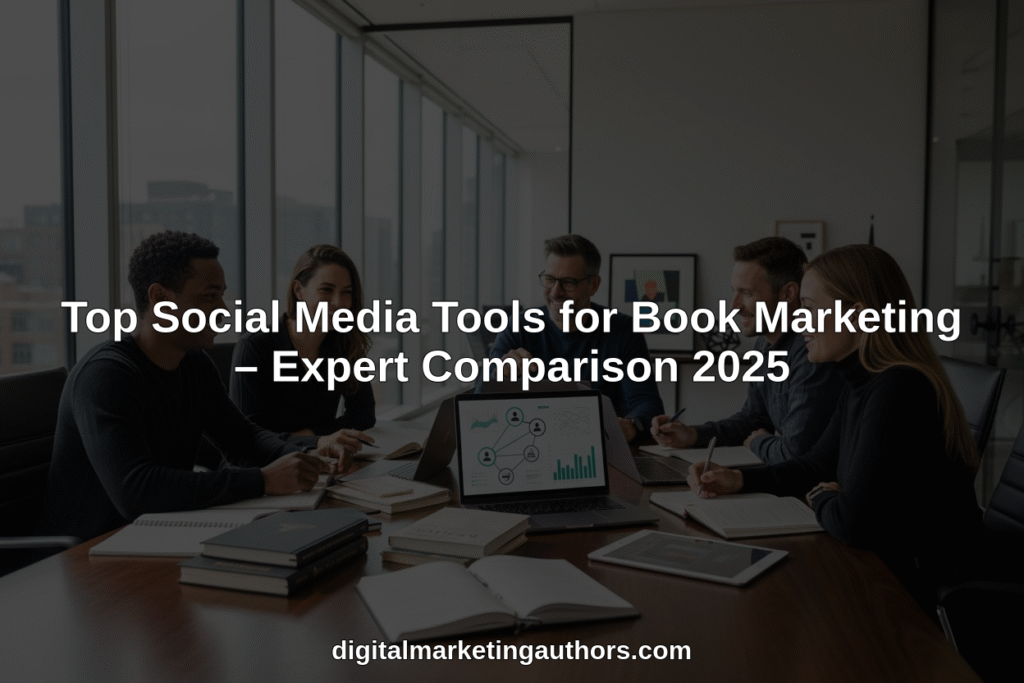
Top Social Media Tools for Book Marketing – Expert Comparison 2025
Every author wants to reach more readers and sell more books, but finding the right tools and advice can feel overwhelming. There are platforms out there promising shortcuts, easy wins, or expert coaching, yet it can be tough to know which actually delivers. Some focus on smart marketing systems, some make book design a breeze, and others offer powerful ways to build your audience and stay connected without getting lost in technical details. Imagine discovering a resource built just for writers that puts practical ideas within reach, whether you want to polish your book cover, grow your email list, or plan your next big release. The real question is which solution best matches your goals and energy. Each offers a different path to success and hidden advantages waiting to be uncovered.
Table of Contents
Digital Marketing Authors
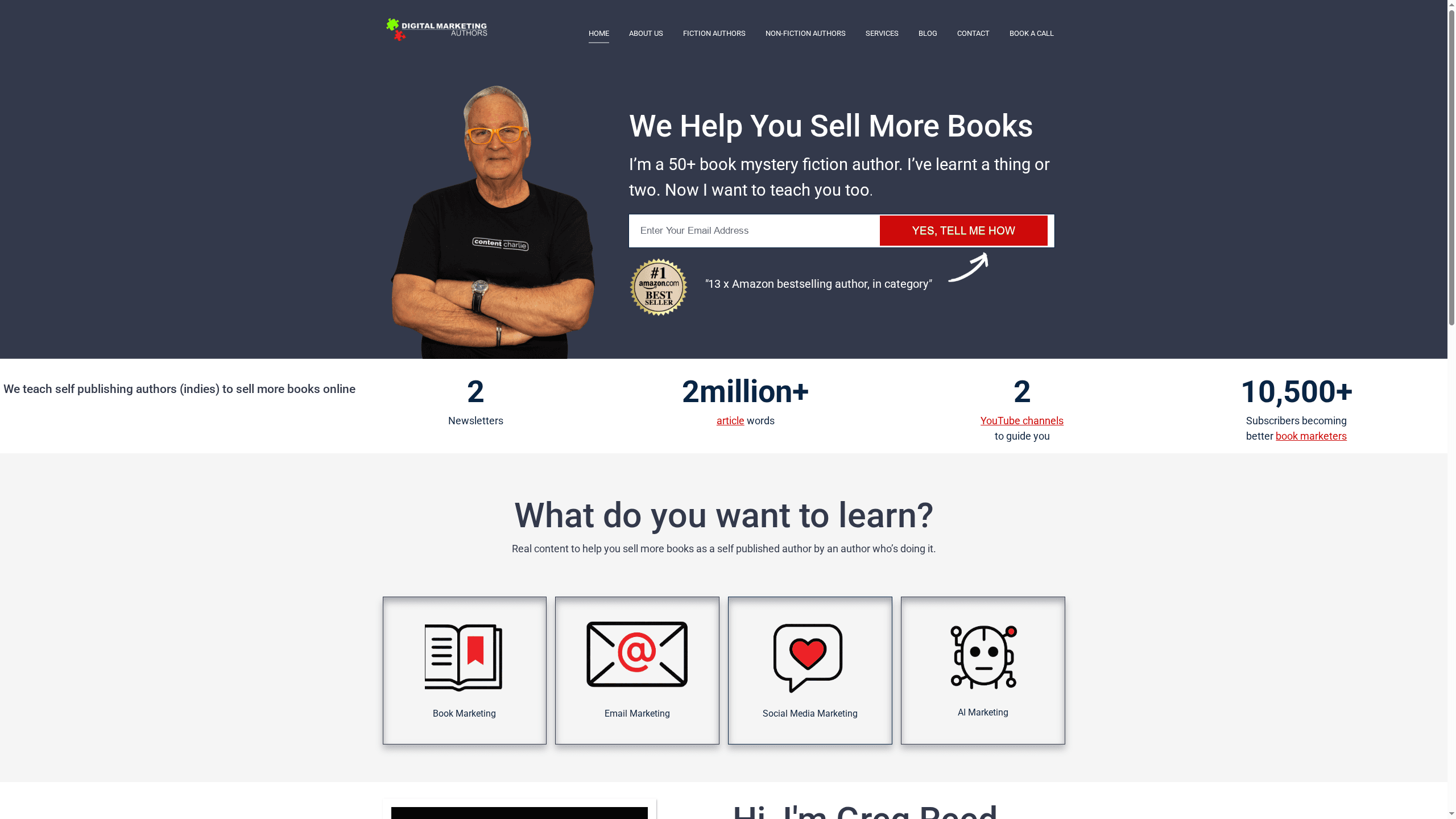
At a Glance
Digital Marketing Authors is a focused, author-first marketing resource that gives indie and self-published writers repeatable systems to sell more books. Founded by 13x #1 Amazon bestselling author C.T. Mitchell, the platform pairs author credibility with practical tactics in email, social media, and AI-driven marketing. If you want training, checklists, and step-by-step guidance aimed specifically at authors (not generic marketers), this is built for you. Expect hands-on strategies rather than vague theory.
Core Features
Digital Marketing Authors delivers targeted guides and training on email marketing, social media promotion, AI-assisted marketing, and content creation designed for book launches and ongoing audience growth. The site bundles strategic playbooks — like list-building funnels and magnetic email sequences — with resource articles such as marketing checklists and tool comparisons. Training materials emphasize automation and reader-community building, helping authors move from one-off promotions to scalable systems that consistently convert readers into repeat buyers.
Pros
- Led by a proven author-marketer: The platform is founded by 13x #1 Amazon bestselling author C.T. Mitchell, so guidance is grounded in real publishing experience and measurable results.
- Author-specific focus: Materials are tailored for self-published and indie writers, meaning examples, templates, and timelines reflect book marketing realities rather than broader corporate campaigns.
- Comprehensive, practical resources: The site includes checklists, tool comparisons, and step-by-step tutorials that let you implement tactics immediately rather than spending weeks learning theory.
- Modern marketing with AI integration: Training explicitly covers AI-powered techniques to save time and boost discoverability, keeping your marketing current and efficient.
- Proven sales and engagement methods: The platform prioritizes systems that grow email lists, automate sales funnels, and nurture a loyal reader base—methods proven to increase book sales over time.
Who It’s For
Digital Marketing Authors is ideal for self-published and indie authors who want to take control of their book marketing with systems that scale. If you write fiction or nonfiction and are committed to learning and applying practical tactics—email funnels, social media promotion, and AI-assisted content creation—this platform will accelerate your results. It’s particularly useful for authors who prefer actionable templates and checklists over academic marketing advice.
Unique Value Proposition
Digital Marketing Authors stands out because it combines frontline author credibility with explicit, execution-focused marketing systems. Unlike generic marketing platforms, it translates book marketing into repeatable playbooks: list-building tactics, automated email sequences, social media content calendars, and AI workflows tailored to book discovery. The emphasis on building a loyal reader army and automating sales moves authors away from one-hit launches and toward sustainable revenue. Backed by a bestselling author, the guidance is both strategic and granular — from subject-line formulas to promotion timing — making it superior for authors who need results without reinventing the wheel.
Real World Use Case
An independent mystery author uses the platform to grow an email list via targeted lead magnets, schedules a four-week social campaign for a new release, and deploys AI to create promotional copy and audience segments. The result: higher open rates, more preorders, and a measurable uplift in long-term reader engagement.
Pricing
Not specified on the website.
Website: https://digitalmarketingauthors.com
Kindlepreneur
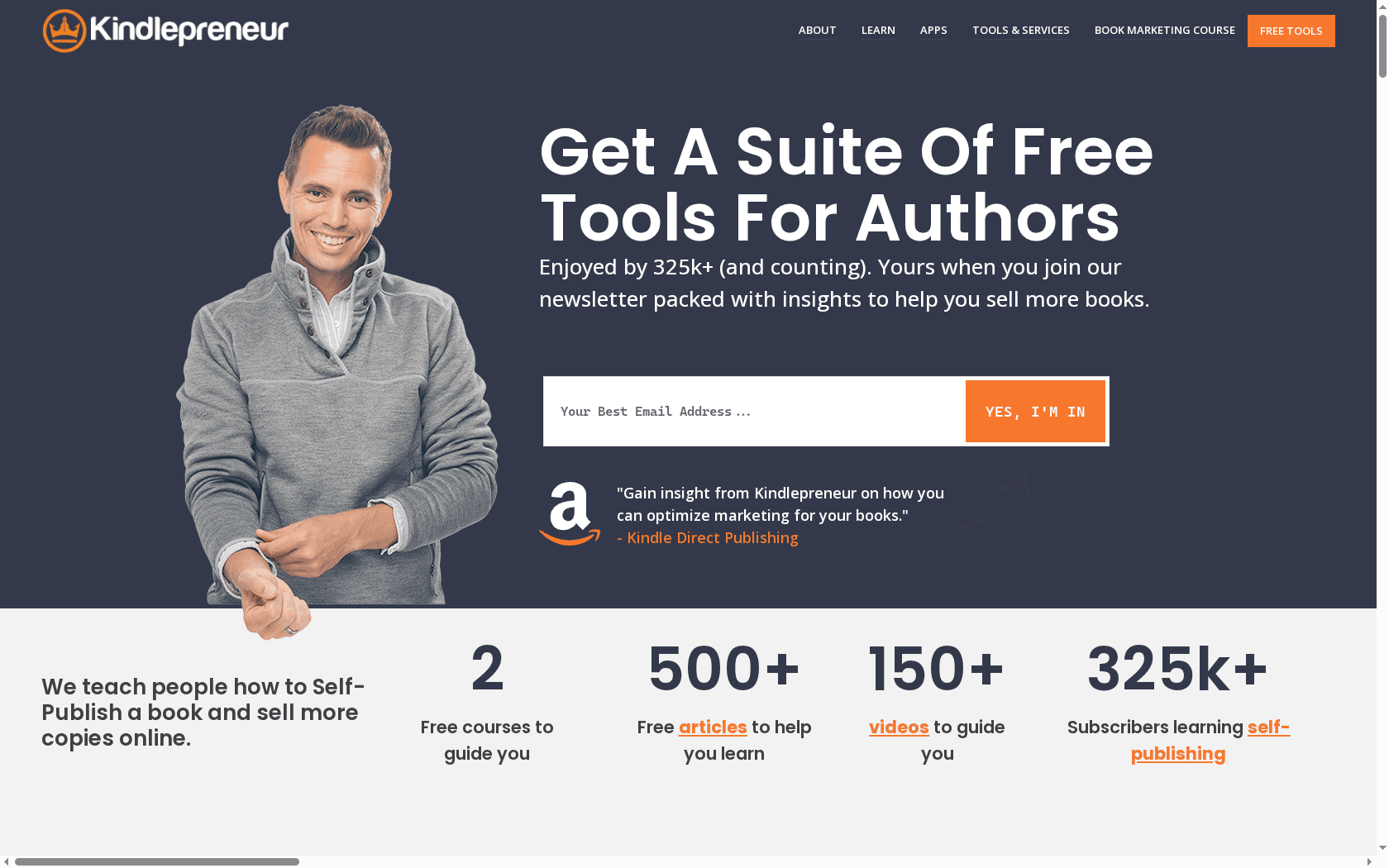
At a Glance
Kindlepreneur is a deep repository of free education and hands-on tools created for self-publishing authors who want practical, Amazon-focused book marketing help. Founded and curated by Dave Chesson, it combines more than 500 articles, 150+ videos, and a collection of free utilities that authors can use without a credit card. If you sell (or plan to sell) through Amazon KDP, Kindlepreneur delivers high-value, actionable material; outside Amazon, its relevance tapers off. Bottom line: a must-visit hub for Amazon-centric indie authors.
Core Features
Kindlepreneur’s core is educational content plus utility tools: free courses on self-publishing and book marketing, a library of over 500 written guides, 150+ instructional videos, and practical tools such as an Amazon sales rank calculator, book description generator, and QR code creator. The site also hosts resources on branding, cover design, editing, formatting, and publishing workflows—packaged to move an author from confusion to measurable action steps.
Pros
- Extensive free content: Kindlepreneur offers hundreds of articles and many videos so you can learn multiple aspects of publishing without immediate cost.
- Practical tools for Amazon sellers: Tools like the sales rank calculator and description generator give you quick, usable metrics and assets to improve listings.
- Authored by an experienced strategist: Guidance comes from a recognized self-publishing expert, which helps the advice feel grounded and credible.
- Supports all experience levels: Whether you’re writing your first indie novel or you’re a seasoned indie marketer, the site includes beginner courses and advanced tactics.
- Large engaged audience: A community of over 325,000 subscribers signals ongoing value and regular updates.
Cons
- Amazon-centric focus can limit applicability: The content and tools primarily target Kindle Direct Publishing, which reduces usefulness for authors pursuing other retailers or non-Amazon strategies.
- Some features behind paywalls: While most resources are free, certain advanced tools or courses may require payment or upgrades to access full functionality.
- Variable fit depending on skill level: The quality and usefulness of specific articles or tools can vary based on where you are in your author journey and your prior knowledge.
Who It’s For
Kindlepreneur is ideal for indie authors, self-publishers, and indie marketers who rely on—or plan to rely on—Amazon KDP as a primary sales channel. If you want step-by-step tutorials, free calculators, and tactical advice that you can apply the same day, this site was built for you.
Unique Value Proposition
Kindlepreneur stands out by pairing deep, free educational content with immediately actionable tools focused on Amazon performance. That combination lets authors both learn strategic concepts and run the tiny experiments that move visibility and sales.
Real World Use Case
An indie author uses Kindlepreneur’s Amazon sales rank calculator to estimate daily sales, applies learnings from articles to refine their Amazon Ads, and follows a free course to tighten book descriptions and metadata—resulting in clearer listings and measurable uplift in visibility.
Pricing
Free tier available; some premium tools and services may require payment.
Website: https://kindlepreneur.com
Book Brush
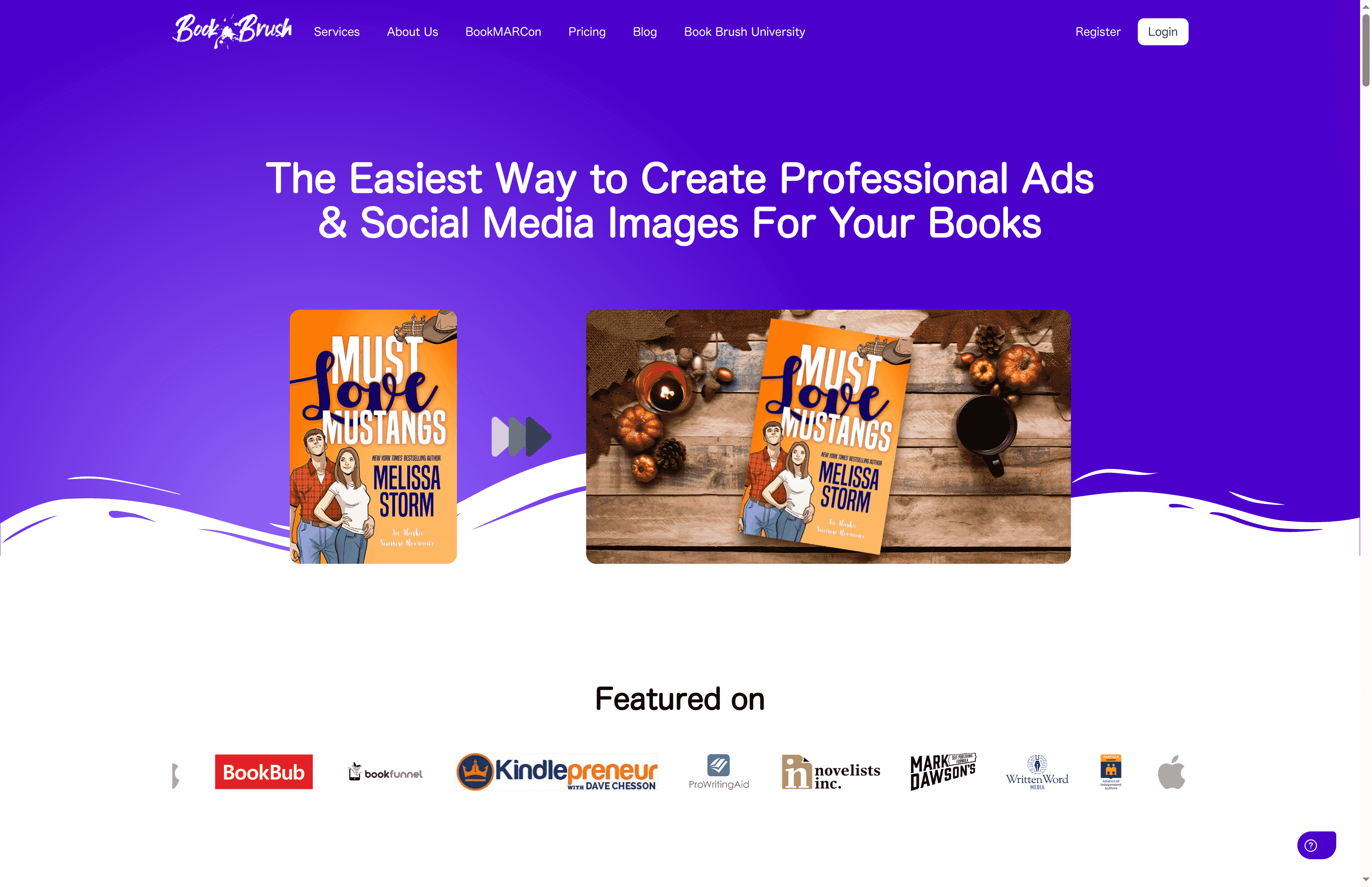
At a Glance
Book Brush is a purpose-built visual toolkit that helps authors produce professional covers, ads, mockups, and animated promos without hiring a designer. Its template library and 3D mockup options accelerate campaign-ready assets, making it a practical choice for busy indie authors and small publishers. It’s not a full-featured photo editor, though — expect convenience over pixel-perfect control.
Core Features
Book Brush bundles a large template library (over 3,000 templates) organized by platform and genre, a cover creator with hundreds of templates, and more than 200 fully customizable 3D book templates for instant mockups. The platform supports box set creation with spine options and uploads for print, ebook, audio, and other formats, and produces animated mockups and social-media-ready videos. Additional capabilities include a reader hub for sharing images, brand-consistent custom design integration, social media management services, and full-service author branding and design services.
Pros
- User-friendly interface with a wide variety of customizable templates: The platform’s organized template library lets you find genre-appropriate layouts quickly so you can build promos in minutes.
- Time-saving tools such as instant mockups and cover creators: Instant mockups and pre-built cover templates dramatically reduce the hours spent assembling campaign images.
- Affordable alternative to hiring graphic designers: For authors on a budget, Book Brush bundles many design needs into one subscription, which commonly costs less than multiple freelance jobs.
- Comprehensive suite of marketing tools tailored for authors: From covers to animated videos to box sets, the feature set maps closely to the typical tasks of book launches and ongoing promotions.
- Ability to create a consistent brand presence across multiple formats: Integration of custom designs and templated assets helps maintain cohesive branding across social posts, ads, and storefront imagery.
Cons
- Limited information on advanced editing features or unique customization options: The platform appears to favor templated workflows over deep, pixel-level editing, which may frustrate authors who want fine-grained control.
- Pricing plans may be expensive for some individual authors or small publishers: Annual plans starting at $149 may be a stretch for authors just testing paid promotion or those with very tight budgets.
- Potential learning curve for new users unfamiliar with graphic design tools: While templates simplify many tasks, authors new to visual tools may still need time to master branding consistency and animation options.
Who It’s For
Book Brush is ideal for indie authors, self-published writers, and small publishers who want fast, polished visual assets without outsourcing. If you run your own book launches and need social ads, mockups, and cover variants produced quickly, Book Brush gives you the assembly line you need.
Unique Value Proposition
Book Brush’s strength is convenience: it packages author-specific design templates, 3D mockups, animated social content, and basic brand services into a single, author-focused platform—so you can move from concept to campaign in hours instead of days.
Real World Use Case
An author preparing a release uses Book Brush to design the book cover, create promotional social graphics, generate animated teaser videos, and produce consistent box set imagery for retailer pages and ad campaigns.
Pricing
Plans range from $149/year for the Plus plan to $246/year for the Platinum plan, with higher tiers offering unlimited downloads, trailer creators, additional mockups, and webinars.
Website: https://bookbrush.com
StoryOrigin
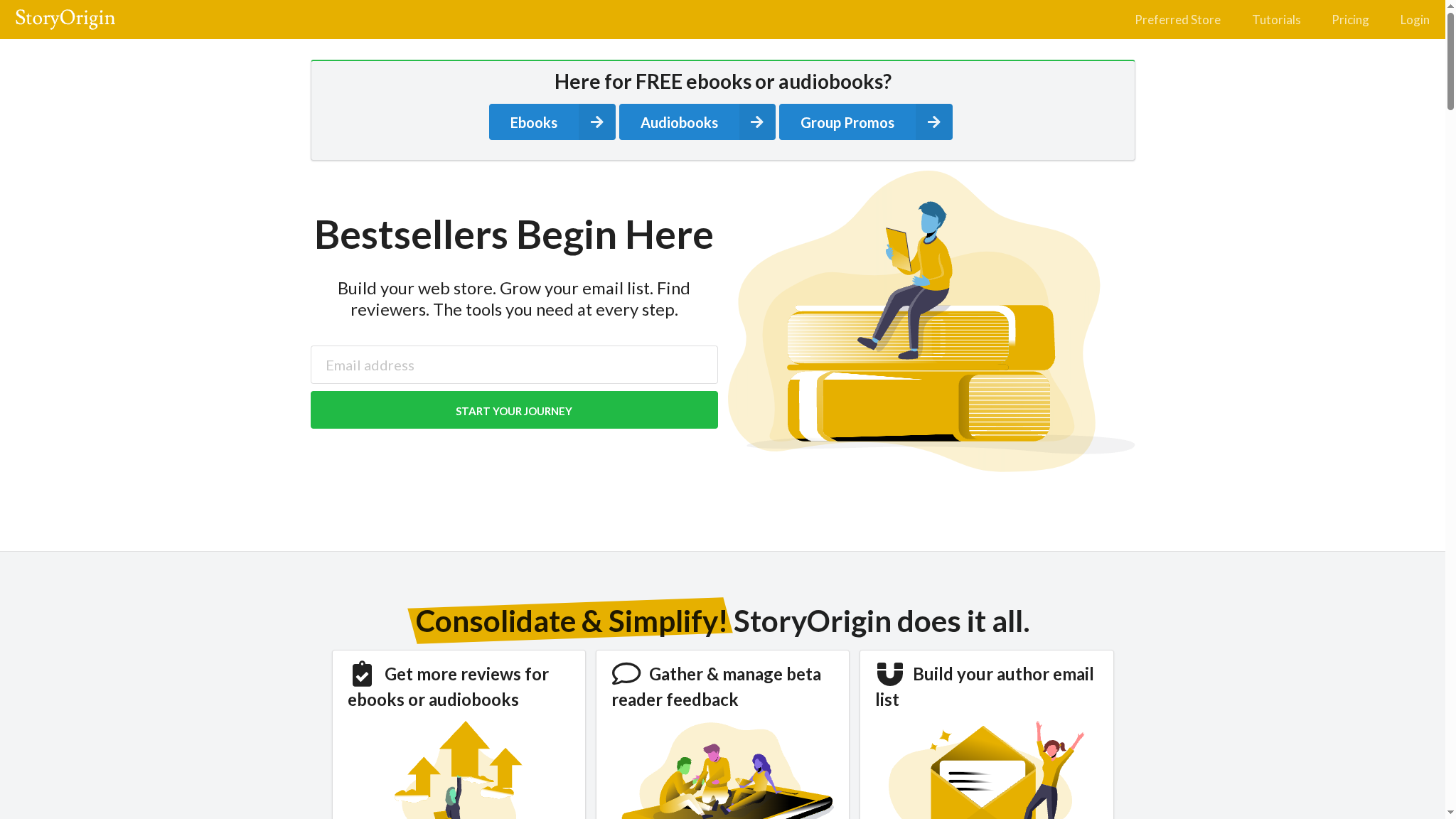
At a Glance
StoryOrigin is an all-in-one author marketing hub built to help indie and traditionally published authors grow mailing lists, manage reviews, and run collaborative promotions without juggling half a dozen separate tools. It combines list-building, reviewer outreach, newsletter swaps, and universal links into a single platform, which can save time and reduce manual follow-up. That breadth is StoryOrigin’s biggest strength — but the payoff requires a learning curve and, for many useful features, a paid plan.
Core Features
StoryOrigin’s capabilities center on streamlining author workflows: build email lists with reader magnets and landing pages; find, vet, and distribute review copies for ebooks and audiobooks; create and coordinate newsletter swaps and group promos; and generate universal links that send readers to the best store per country or preference. It also offers audiobook promo code distribution, beta reader feedback with embedded questionnaires, built-in calendars and campaign planners, writing goal tracking, and automation for reviewer follow-up and download delivery.
Not everything is surface-level. Many tasks that usually require spreadsheets or separate services—review tracking, universal links, and promo coordination—are automated inside the platform. That saves mental overhead. And yes, you can build a basic author website here, too. Small wins add up.
Stop. Think.
Pros
- All-in-one platform reduces tool sprawl: By combining list-building, review management, promotions, and universal links, StoryOrigin cuts the need to cobble together multiple services. This centralization saves time and reduces errors.
- User-friendly interface with depth: The platform is described as easy to use while still offering a long feature list, making it approachable for authors who want more than a single-purpose app.
- Strong community and positive social proof: The product benefits from a supportive author community, which can accelerate learning and provide promo partners.
- Flexible promotional options: Newsletter swaps, group promos, and automated reviewer workflows give authors multiple ways to reach readers and coordinate with other authors.
- Comprehensive review and feedback tracking: From ARC distribution to embedded beta-reader questionnaires, StoryOrigin helps you collect and manage feedback systematically.
Cons
- Complex for new users: Because StoryOrigin bundles many features, initial navigation can feel overwhelming, especially for authors who prefer minimal tools.
- Key features behind paid tiers: Several of the most useful capabilities—group promos, newsletter swaps, and advanced review management—require the Standard plan, limiting the free tier’s practicality.
- Limited free features: The free basic plan exists, but most authors aiming for real list growth and promo coordination will need to upgrade to access value-driving tools.
Who It’s For
StoryOrigin suits authors and indie writers who are serious about growing an audience and managing promotions efficiently. If you run newsletter swaps, share ARCs, or coordinate multi-author promos, StoryOrigin streamlines those tasks and reduces back-and-forth. It’s less ideal for authors who want a single, ultra-simple tool without any setup.
Unique Value Proposition
StoryOrigin’s unique value lies in packing multiple author-specific marketing tools into one platform tailored to the book ecosystem: reviewer discovery, ARC distribution, universal links for global sales, and campaign planning live together so you can coordinate launches and promos without spreadsheets.
Real World Use Case
An indie author uses StoryOrigin to organize newsletter swaps, distribute ARC copies to vetted reviewers, and create universal links for a recent release. The result: smoother ARC delivery, clearer review tracking, and a stronger mailing list ready for launch announcements.
Pricing
Starting at Free; Standard plan $10/month or $100/year, with an optional guided setup that involves a setup fee.
Website: https://storyoriginapp.com
Publer
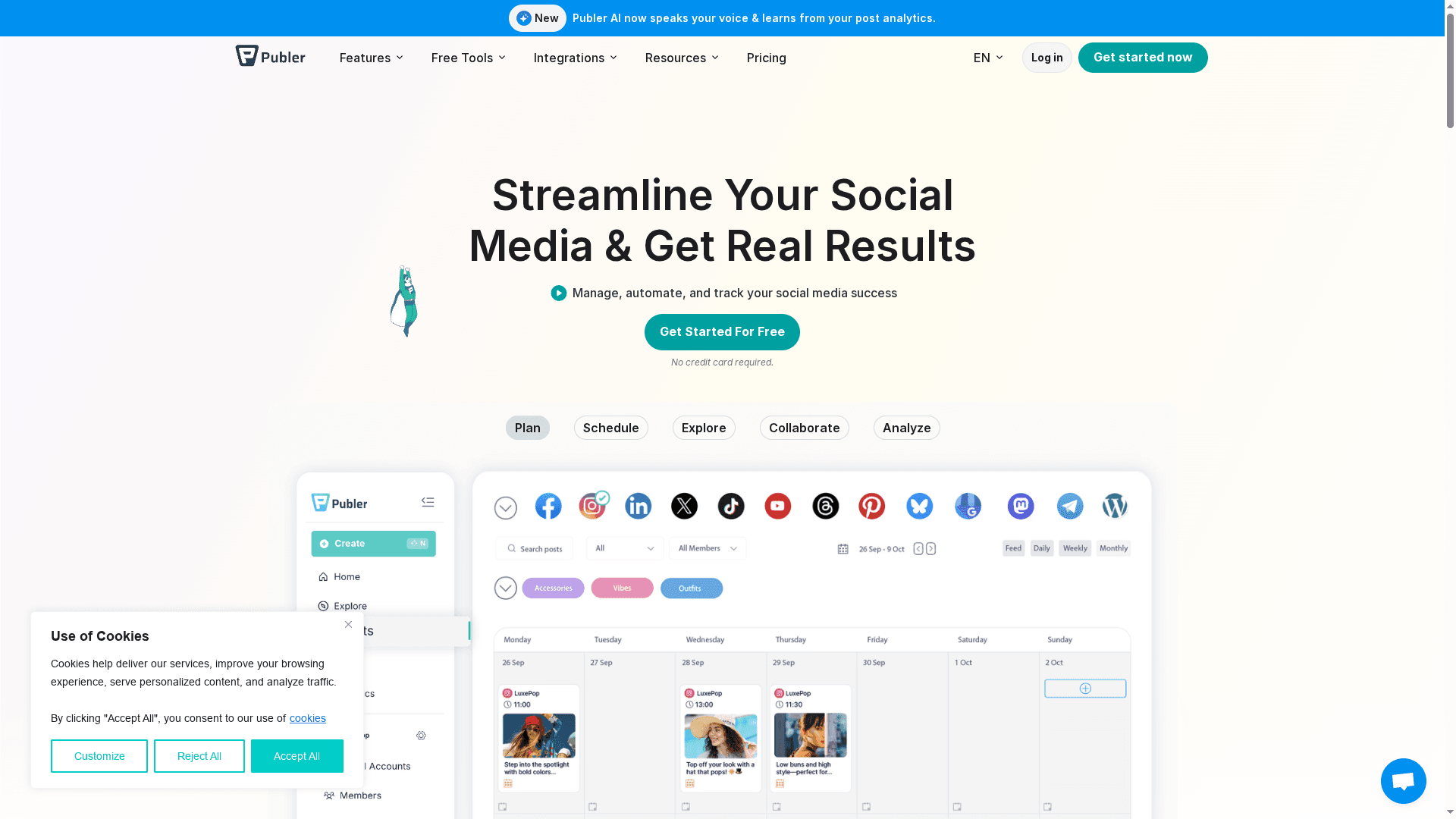
At a Glance
Publer is a full-featured social media management platform built to simplify scheduling, automation, and analytics across multiple networks. For authors and book marketers, it offers practical tools—bulk scheduling, content recycling, and AI-assisted writing—that reduce repetitive work and keep your feed consistent. It’s approachable for solo authors but scalable enough for agencies and marketing teams. Expect a short learning curve for advanced automation, and consider paid plans for larger teams or heavy feature use.
Core Features
Publer centers on cross-platform social media scheduling and automation, with built-in content creation and editing tools so you can craft posts without leaving the app. It supports analytics and insights to track performance, collaboration and approval workflows for teams and clients, and bulk uploading via CSV or a multi-post scheduler for rapid campaign setup. Additional capabilities include AI content generation, link-in-bio management, content recycling, and integrations with popular design and storage tools.
Pros
- User-friendly interface with a drag-and-drop calendar makes planning weeks of posts quick and visual. This lowers the friction for authors who prefer visual scheduling over spreadsheets.
- Comprehensive automation tools including auto-schedule and recycling reduce manual reposting and keep evergreen content working for you. Save time and maintain presence without constant oversight.
- Deep analytics provide the data you need for better decision-making about what content actually drives engagement. That’s crucial when every promotional post should move the needle on visibility or sales.
- Integration with tools like Canva and Google Drive streamlines content creation and asset management. You can pull visuals and drafts into Publer without broken workflows.
- Flexible plans cater to individuals, businesses, and enterprises so you can scale as your audience grows. Start small and upgrade when you need team features.
Cons
- Some features are limited in free plans, which can frustrate users who want to trial advanced automation and analytics. You may hit restrictions before you’ve tested the tool fully.
- Pricing can be high for larger teams or advanced features, making it a significant monthly commitment for agencies managing many client accounts. Budget accordingly.
- There is a learning curve for extensive automation options, so expect to invest time to set up complex recycling or approval workflows correctly. Don’t assume everything will work optimally out of the box.
Who It’s For
Publer is ideal for social media managers, small business owners, content creators, agencies, and enterprise marketing teams who need an integrated platform to schedule, automate, and analyze social content. If you manage multiple author profiles or client accounts and value bulk operations and collaboration, Publer fits well.
Unique Value Proposition
Publer’s value lies in combining practical automation—bulk scheduling, recycling, and AI content assistance—with collaboration and analytics in one interface. For authors, that means less time juggling posts and more time writing, while teams gain clearer approval workflows and measurable performance data.
Real World Use Case
A digital marketing agency uses Publer to schedule and analyze posts across several clients’ accounts, automate content recycling for evergreen promotions, and share drafts with clients for approval—streamlining campaign workflows and reducing manual coordination.
Pricing
Free tier available; paid plans include Professional, Business, and Enterprise with varying features and custom options.
Website: https://publer.io
Author Marketing Tools Comparison
Here’s a comprehensive comparison of popular author marketing tools, showcasing their unique features, pros, cons, and pricing to help authors make informed decisions.
| Tool | Key Features | Pros | Cons | Pricing |
|---|---|---|---|---|
| Digital Marketing Authors | Email, Social Media, AI Marketing Templates & Checklists for Authors |
Proven Author Insights Comprehensive Resources Modern with AI Integration |
Pricing not specified | Not specified |
| Kindlepreneur | Amazon-focused Tools & Courses 500+ Articles, 150+ Videos |
Extensive Free Content Amazon Tools for Sellers Large Audience |
Amazon-centric Focus Some Paywalls |
Free, Some Paid Features |
| Book Brush | 3,000+ Templates Cover Creator, 3D Mockups, Animation |
User-Friendly Time-Saving Tools Affordable Design Solutions |
Limited Advanced Editing Learning Curve Pricing High for Some |
$149-$246/year |
| StoryOrigin | Email & Review Management Newsletter Swaps, Universal Links |
All-in-One Platform User-Friendly Strong Community |
Complex for New Users Most Features Paid |
$0-$10/month |
| Publer | Social Media Management Automation, Bulk Scheduling |
User-Friendly Interface Comprehensive Automation Deep Analytics |
Limited Free Features High Pricing for Advanced Features |
Free, Paid Plans Available |
Master Social Media Marketing for Your Books with Proven Systems
Social media marketing can feel overwhelming when you face scattered tools and unclear strategies. This article highlights the challenge of finding the right platforms and automation to save time while boosting book visibility and sales. If you are struggling to manage posts, engage readers consistently, and turn casual followers into loyal fans, you are not alone. Key goals include simplifying scheduling, maximizing engagement, and leveraging AI-powered content creation to work smarter not harder.
At Digital Marketing Authors, we understand these struggles deeply. Founded by 13x #1 Amazon bestselling author C.T. Mitchell, our platform focuses exactly on helping authors build scalable, repeatable marketing systems—from magnetic email sequences to AI-enhanced social media workflows. We give you templates, checklists, and step-by-step playbooks tailored for authors who want to stop guessing and start selling more books.
Tap into expert strategies that transform your social media chaos into a streamlined engine for growth.

Ready to stop spinning your wheels and grow a loyal reader community with less stress? Explore our proven author marketing frameworks and AI tools now at Digital Marketing Authors. Start marketing smarter today and watch your book sales accelerate with actionable guidance designed for indie authors just like you.
Frequently Asked Questions
What are the essential social media tools for book marketing in 2025?
To effectively market books in 2025, essential social media tools include scheduling platforms for posts, analytics software for performance tracking, and audience engagement tools. Begin by assessing your needs for automation and analytics to select tools that promote consistent engagement with readers.
How do I automate my social media posts for book marketing?
To automate social media posts, utilize a scheduling tool that allows you to queue up multiple posts in advance. Set aside time weekly to create content and schedule posts, ensuring you maintain a steady online presence without daily management.
What metrics should I track to measure my book marketing success on social media?
Key metrics to track include engagement rates, follower growth, and post reach. Focus on monthly reports to analyze trends; for example, aim for a 10% increase in engagement over the next quarter by refining your content strategy.
How can I grow my audience using social media tools?
Use audience engagement tools to create interactive content, such as polls or giveaways, that encourages followers to participate and share. Aim for a campaign that targets a 15% increase in followers within 30 days by offering engaging visuals and dynamic posts.
What types of content should I share on social media to promote my books?
Share a mix of engaging content like behind-the-scenes insights, reader testimonials, and excerpts from your book. Plan a content calendar with at least one promotional post per week to keep your audience engaged and informed.
Can I collaborate with other authors using social media tools?
Yes, many social media tools facilitate collaboration by allowing content sharing and coordinated campaigns. Establish partnerships and plan joint promotions to expand your reach, aiming to increase collective followership by up to 25% within a couple of months.
Recommended

Digital Marketing for Writers: Grow and Sell More Books
Nearly 70% of self-published authors struggle to reach their ideal readers and grow book sales effectively. Without a clear marketing plan, even the best writing can go unnoticed. Understanding practical strategies for defining your audience, building an author platform, and using smart tools can help transform your book’s visibility and sales results.
Table of Contents
- Step 1: Define Your Target Audience And Author Goals
- Step 2: Build A Professional Author Platform
- Step 3: Craft Compelling Email Marketing Campaigns
- Step 4: Leverage Ai Tools To Boost Visibility
- Step 5: Automate Book Sales And Optimize Results
Quick Summary
| Key Point | Explanation |
|---|---|
| 1. Define your audience meticulously | Understand demographics and psychological traits to effectively target your book’s readers. |
| 2. Build a cohesive author platform | Create a professional website, active blog, and social media presence to connect with readers. |
| 3. Craft personalized email marketing | Segment your email list and create engaging content to convert casual readers into loyal fans. |
| 4. Leverage AI tools for efficiency | Use AI to automate tasks like content generation and ad optimization, freeing up your time for writing. |
| 5. Automate marketing processes | Set up automated systems for advertising and email marketing that work continuously without manual input. |
Step 1: Define your target audience and author goals
Successful book marketing starts with crystal clear understanding of who will read your book and what you want to achieve. This foundational step determines every subsequent marketing strategy you will develop.
Begin by creating a detailed reader persona that goes beyond basic demographics. According to research from digital marketing experts, effective audience targeting requires understanding not just age and location but deeper psychological characteristics like reading habits, interests, and pain points.
Ask yourself specific questions about your ideal reader: What motivates them to pick up a book like yours? What problems are they trying to solve? What emotional experience are they seeking? For instance, a romance novelist might target professional women aged 30-45 who want escapist literature after stressful workdays.
Align your specific author goals with your audience research. Are you aiming to:
- Build a loyal reader community
- Generate consistent book sales
- Establish yourself as an authority in your genre
- Create a sustainable author income stream
- Expand your readership internationally
Research indicates that authors who precisely define both audience and objectives are 67% more likely to create targeted marketing campaigns that actually work.
Pro Tip: Update your reader persona every six months as your writing career evolves and you gain more insights about your audience.
Next, you will map out a strategic marketing approach that speaks directly to your carefully defined reader persona.
Step 2: Build a professional author platform
Your author platform is your digital home base where readers discover and connect with your writing. It transforms you from an unknown writer to a recognized brand with consistent online presence.
According to digital marketing research from Elsevier’s marketing strategies guide, an effective author platform integrates multiple digital touchpoints to maximize audience reach. This means creating a cohesive online ecosystem that tells your unique storytelling narrative.
Start by establishing these core digital assets:
Here’s a comparison of the core elements of a professional author platform:
| Element | Purpose | Key Tips |
|---|---|---|
| Author Website | Main information hub | Clean design Clear branding |
| Blog | Showcases expertise and updates | Consistent posts Engage readers |
| Social Media Profiles | Builds community and discoverability | Focus on top 2-3 platforms |
| Email Newsletter | Direct reader connection and updates | Value-first Personal approach |
- Professional author website showcasing your books and biography
- Active blog demonstrating your writing expertise
- Consistent social media profiles on platforms where your target readers spend time
- Email newsletter for direct reader communication
Your website serves as the central hub. Make it clean, professional, and reflective of your writing genre. Include high quality author photos, book descriptions, purchase links, and ways for readers to connect with you.

Social media allows you to build personal connections. Choose 2-3 platforms where your ideal readers congregate. For fiction writers, this might mean Instagram and TikTok. For nonfiction authors, LinkedIn and Twitter could be more strategic.
Pro Tip: Consistency matters more than perfection. Regular small updates beat sporadic grand gestures.
Growing an author platform requires patience and strategic effort. Your next step involves creating compelling content that attracts and retains your ideal readers.
Step 3: Craft compelling email marketing campaigns
Email marketing transforms casual readers into loyal fans and consistent book buyers. Your goal is creating magnetic email sequences that readers actually want to open and engage with.
According to research from Automateed’s book marketing guide, successful email campaigns rely on personalized sequences that nurture readers through strategic touchpoints. This means designing emails that feel like personal conversations rather than generic broadcasts.
Start by segmenting your email list based on reader interests and behaviors. Fiction writers might create different tracks for romance versus thriller fans. Nonfiction authors could segment by professional interests or reading preferences.
Your email sequence should include:
- Welcome email introducing yourself and your writing
- Engagement emails sharing behind the scenes content- Promotional emails highlighting new book releases
- Value driven content that entertains or educates
Pay special attention to your subject lines. They are your first and sometimes only chance to capture a reader’s attention. Make them intriguing personal and specific to your reader’s interests.
As Automateed’s author email marketing research demonstrates, converting subscribers requires offering exclusive benefits. Think about providing special reader rewards like chapter previews bonus content or limited time discounts.
Pro Tip: Aim for an 80/20 balance. Spend 80% of your emails providing value and only 20% directly selling.
Effective email campaigns are an art form that develops with practice. Your next step involves analyzing your email performance and continuously refining your approach.
Step 4: Leverage AI tools to boost visibility
AI technology has transformed book marketing from a time consuming process to a strategic powerhouse. Your goal is using intelligent tools that amplify your reach while saving precious writing time.
According to Manuscript Report’s comprehensive AI publishing guide, AI can automate multiple visibility boosting tasks across different marketing channels. This means generating social media content email sequences and optimizing advertising with unprecedented precision.
Start exploring AI tools in these key areas:
- Social media content generation
- Email marketing optimization
- Amazon ad targeting
- Book description refinement
- Reader targeting analysis
For social media marketing AI can help draft engaging posts that sound authentically like your writing voice. These tools analyze your previous content and generate posts that match your style and resonate with your target audience.
In email marketing AI becomes your strategic partner. As Anyword’s marketing platform demonstrates, intelligent systems can generate email subject lines optimize send times and predict which messaging will most likely convert readers into book buyers.
When it comes to advertising AI tools can analyze complex data points to identify your most promising reader demographics. This means smarter ad spending and higher conversion rates.
Pro Tip: Always review and personalize AI generated content. The tool provides the framework but your unique voice makes it compelling.
AI book marketing represents the future of author promotion. Your next step involves experimenting with these tools and measuring their impact on your book sales and reader engagement.
Step 5: Automate book sales and optimize results
Automation transforms book marketing from a manual grind into a strategic growth engine. Your mission is creating systems that sell books while you focus on writing.
According to Automateed’s book marketing automation guide, successful automation requires setting up intelligent advertising platforms that monitor and adjust campaigns in real time. This means creating systems that work continuously without constant manual intervention.
Key automation strategies include:
- Setting up perpetual Amazon advertising campaigns
- Creating evergreen email marketing sequences
- Implementing retargeting ads for website visitors
- Developing automated social media content schedules
- Building reader acquisition funnels
Amazon advertising presents a prime opportunity for automation. Manuscript Report’s AI publishing analysis reveals that intelligent bid adjustment tools can dramatically reduce advertising costs while maintaining strong visibility.
Your email marketing should function like a silent sales team. Design sequences that automatically welcome new subscribers trigger follow up messages based on reader interactions and recommend books without constant oversight.
Track your key performance indicators religiously. Watch metrics like cost per click conversion rates and return on ad spend. These numbers tell you exactly how your automated systems perform.
Pro Tip: Review your automation systems monthly. Small tweaks can generate significant performance improvements.
Book sales funnel optimization is an ongoing process. Your next step involves continuously refining these automated systems to maximize your book sales potential.
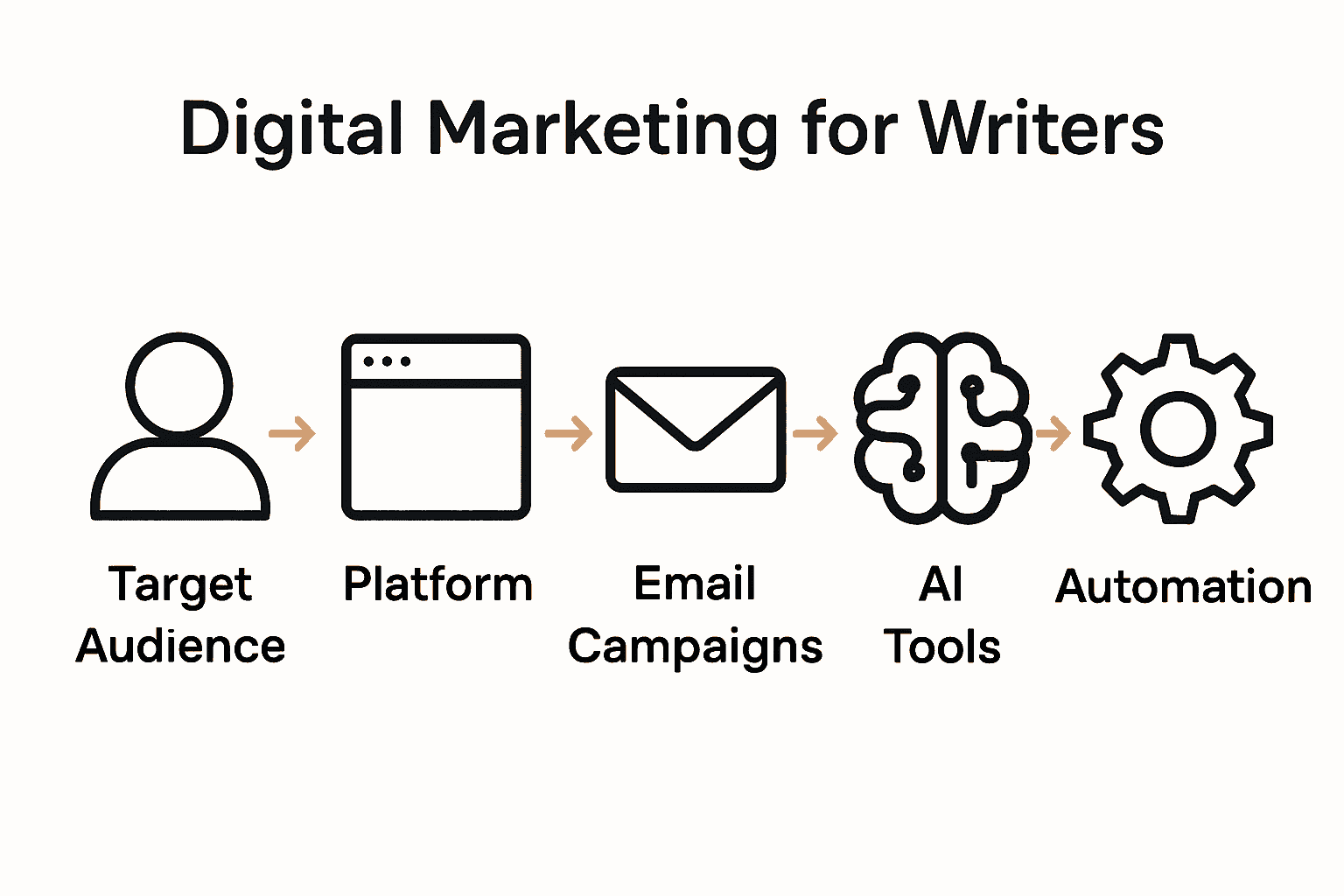
Unlock Your Full Book Marketing Potential Today
If you’ve ever felt overwhelmed trying to connect with your ideal readers or struggled to turn casual interest into loyal fans, you are not alone. This article highlights the importance of defining your target audience, building a professional author platform, crafting magnetic email marketing, and harnessing AI tools to automate and amplify your book sales. These challenges often leave writers searching for clear, proven systems that can actually deliver results.
At DigitalMarketingAuthors.com, we understand these exact struggles and the critical goals you want to achieve: growing a dedicated reader community, automating sales, and scaling your author brand without wasting precious time or resources. Founded by 13x #1 Amazon bestselling author C.T. Mitchell, our platform offers step-by-step strategies and AI-powered solutions that turn ambitious marketing plans into consistent book sales and broader visibility.
Ready to stop guessing and start growing

Discover how to build your professional author platform and craft compelling email campaigns that truly resonate. Take control of your marketing journey right now and visit Digital Marketing Authors to access expert guidance and tools tailored for indie authors who want to market smarter, sell faster, and scale worldwide. Your next bestselling chapter begins with the right marketing system.
Frequently Asked Questions
How can I define my target audience for effective book marketing?
To define your target audience, create a detailed reader persona that includes not just demographics, but also psychological factors like interests and pain points. Start by asking specific questions about what motivates your ideal reader, what problems they want to solve, and what emotional connection they seek from your book.
What are the essential elements of a professional author platform?
A professional author platform should include a user-friendly website, an active blog, social media profiles, and an email newsletter. Focus on creating a cohesive online presence that reflects your genre and allows you to connect with readers effectively.
How should I structure my email marketing campaigns to engage readers?
Structure your email marketing campaigns around personalized sequences that nurture your readers. Include a warm welcome email, engaging content that offers behind-the-scenes glimpses, and promotional emails that announce new releases; aim for an 80/20 balance, providing value in 80% of your emails and selling in 20%.
What AI tools can I use to enhance my book marketing efforts?
Explore AI tools that can assist with generating social media content, optimizing email marketing, and refining book descriptions. Start using these tools to automate repetitive tasks, which can save you time and increase your promotional reach.
How can I automate my book sales to maximize results?
Automate your book sales by setting up continual advertising campaigns, creating evergreen email sequences, and implementing retargeting ads for website visitors. Review your automation processes monthly to identify areas for improvement and boost sales performance by about 20%.
Recommended

Book Preorder Strategies Explained: Complete Guide
Did you know that authors who use preorders can see up to 30 percent more sales during their book’s launch week? Preorder campaigns are quickly becoming a favorite strategy because they help writers build excitement, measure interest, and earn revenue before release day. By learning how effective preorders work, authors can improve their book’s visibility and connect with readers months before the first copy ships.
Table of Contents
- Defining Book Preorders And Their Benefits
- Types Of Preorder Campaigns For Authors
- Step-By-Step Process For Preorder Success
- Leveraging Email, Social, And AI Tools
- Risks, Costs, And Common Preorder Mistakes
Key Takeaways
| Point | Details |
|---|---|
| Strategic Preorders | Book preorders help authors generate early sales, create buzz, and improve visibility on platforms like Amazon. |
| Campaign Types | Authors can utilize various campaign types including direct platform preorders and social media blitzes to maximize engagement. |
| Marketing Execution | Effective preorder strategies rely on compelling metadata, exclusive incentives, and a multi-channel marketing approach. |
| Avoiding Pitfalls | Common mistakes such as poor timing and inadequate audience targeting can undermine preorder success; authors should navigate these risks carefully. |
Defining Book Preorders and Their Benefits
A book preorder represents a strategic marketing approach where readers can purchase and reserve a book before its official release date. This powerful technique allows authors to generate excitement, build anticipation, and secure advanced sales that can significantly impact initial book rankings and visibility.
Book preorders offer multiple strategic advantages for authors. According to the University of California Press, effective preorder campaigns leverage critical metadata like precise publication dates, compelling book descriptions, and targeted keywords to optimize online discoverability. These advanced sales not only help authors gauge reader interest but also provide crucial momentum for launch week performance.
Key benefits of book preorders include:
- Generating early revenue before official publication
- Creating buzz and anticipation around your upcoming release
- Potentially improving initial book rankings on platforms like Amazon
- Providing authors with early sales data and reader engagement metrics
- Allowing readers to secure their copy in advance of the official launch
For independent authors, preorders represent more than just a sales strategy. They are a powerful tool for building reader engagement and creating a sense of community around your upcoming book. Book launch strategies can be significantly enhanced by implementing a well-planned preorder campaign that connects directly with your target audience.
Types of Preorder Campaigns for Authors
Authors can leverage several strategic preorder campaign types to maximize book visibility and reader engagement. These campaigns range from direct platform-based approaches to more complex multi-channel marketing strategies designed to build anticipation and drive early sales.
According to the Self-Publishing Advice Center, independent authors have multiple promotional avenues to explore. Platform-exclusive preorders typically involve focusing on specific retail channels like Amazon KDP, where authors can offer early purchase options with special incentives. These campaigns often include limited-time pricing, exclusive bonus content, or signed edition opportunities to entice early buyers.
Key preorder campaign strategies include:
Here’s a comparison of popular preorder campaign types for authors:
| Campaign Type | Key Features | Best For |
|---|---|---|
| Direct Platform Preorders | Platform exclusivity Easy setup |
Wide reach Amazon focus |
| Email List Campaigns | Personalized offers Direct connection |
Engaged audiences |
| Social Media Preorder Blitz | Viral potential Short-term buzz |
Brand building |
| Influencer Partnership | Third-party endorsement Wider exposure |
Niche audiences |
| Early Bird Discount Campaign | Limited-time pricing Urgency creation |
Value-driven readers |
- Direct Platform Preorders: Using Amazon, Barnes & Noble, and other book retailer platforms
- Email List Campaigns: Targeting existing readers with exclusive preorder opportunities
- Social Media Preorder Blitz: Creating time-limited promotional events across digital channels
- Influencer Partnership Preorders: Collaborating with book reviewers and content creators
- Early Bird Discount Campaigns: Offering reduced pricing for readers who preorder early
For authors seeking comprehensive marketing approaches, book marketing strategies for authors can provide additional insights into creating successful preorder campaigns that connect meaningfully with your target audience and drive initial book sales.

Step-by-Step Process for Preorder Success
Successful book preorder campaigns require meticulous planning and strategic execution. Authors must approach their preorder strategy as a comprehensive marketing journey that begins months before the actual book launch, carefully crafting each stage to maximize reader engagement and potential sales.
According to the University of California Press, the foundation of any successful preorder campaign starts with compelling metadata. This includes creating an attention-grabbing book description, selecting strategic keywords, and ensuring all publication details are accurate and enticing. Research indicates that authors who invest time in developing high-quality metadata significantly improve their book’s online discoverability and potential for early sales.
The comprehensive preorder process typically involves these critical steps:
- Develop Compelling Book Metadata: Create an irresistible book description
- Build Anticipation: Start promoting 3-6 months before release date
- Create Exclusive Preorder Incentives: Design special bonuses for early buyers
- Leverage Multiple Marketing Channels: Utilize email, social media, and author networks
- Track and Adjust: Monitor preorder performance and adapt strategies
Independent authors looking to refine their marketing approach can find additional insights through bestselling author strategy resources that provide advanced techniques for turning preorder campaigns into powerful book launch mechanisms.
Leveraging Email, Social, and AI Tools
Modern book preorder strategies demand a sophisticated approach that integrates digital marketing channels with cutting-edge technological tools. Authors now have unprecedented opportunities to connect with readers and create targeted, personalized promotional campaigns that extend far beyond traditional marketing methods.
According to the University of California Press’s promotional toolkit, effective author marketing requires a multi-channel strategy that seamlessly combines email outreach, social media engagement, and emerging AI technologies. Email marketing remains a powerful tool, allowing authors to develop direct relationships with readers by creating segmented lists, crafting personalized preorder communications, and designing automated follow-up sequences that build anticipation for upcoming book releases.
Key strategies for leveraging digital tools include:
- Targeted Email Campaigns: Segment reader lists and create personalized preorder invitations
- Social Media Countdown: Use platforms like Instagram and Twitter to build excitement
- AI-Powered Content Creation: Generate engaging promotional materials and social media posts
- Automated Marketing Sequences: Design multi-step communication strategies
- Performance Tracking: Use analytics to refine and optimize preorder approaches
Authors looking to stay ahead of the marketing curve can explore AI strategies for book marketing to unlock advanced techniques for transforming their preorder campaigns into highly effective reader engagement mechanisms.
Risks, Costs, and Common Preorder Mistakes
Book preorder campaigns, while powerful, come with potential pitfalls that can derail an author’s marketing strategy. Understanding these risks is crucial for developing a robust and successful preorder approach that minimizes financial exposure and maximizes reader engagement.
According to the Self-Publishing Advice Center, authors must carefully navigate the financial and strategic risks associated with promotional programs. Platform exclusivity can be a significant constraint, particularly with programs like KDP Select, which may limit an author’s ability to distribute their book across multiple sales channels. The University of California Press warns that neglecting critical elements like metadata optimization can severely impact a book’s online discoverability and potential preorder success.
Common preorder mistakes authors should avoid include:
- Insufficient Metadata Preparation: Incomplete or poorly crafted book descriptions
- Unrealistic Pricing Strategies: Setting prices too high or offering inconsistent discounts
- Lack of Audience Targeting: Failing to identify and reach the right reader demographic
- Poor Timing: Starting preorder campaigns too early or too late
- Inadequate Marketing Follow-through: Not maintaining consistent promotional momentum
Independent authors seeking to mitigate risks and optimize their marketing approach can find valuable guidance through book marketing strategies for authors, which provide comprehensive insights into avoiding common preorder campaign pitfalls.
Unlock the Full Potential of Your Book Preorder Campaigns
If you are struggling with building buzz, optimizing metadata, or creating engaging preorder incentives you are not alone. Many authors find it challenging to navigate the complexities of preorder strategies such as email list segmentation, AI-powered content creation, and managing multi-channel marketing efforts. The pain of launching without a strong preorder plan can lead to missed sales and lost momentum.
At DigitalMarketingAuthors.com, founded by 13x #1 Amazon bestselling author C.T. Mitchell, we understand these challenges and offer proven systems designed to help you market smarter and sell faster. Whether you want to craft magnetic email sequences, leverage AI tools for effective promotions, or build a loyal reader community that drives demand before your book’s release, we provide step-by-step support tailored to your goals.

Ready to stop guessing and start growing your preorder success? Visit DigitalMarketingAuthors.com today to explore powerful book marketing strategies for authors and bestselling author strategy resources. Take control of your book launch and watch your preorder sales soar.
Frequently Asked Questions
What are the main benefits of book preorders for authors?
Book preorders help authors generate early revenue, create buzz around their release, improve initial book rankings, provide early sales data, and allow readers to secure their copy ahead of launch.
What types of preorder campaigns can authors implement?
Authors can use various preorder campaign types, including direct platform preorders, email list campaigns, social media preorder blitzes, influencer partnerships, and early bird discount campaigns to maximize visibility and engagement.
What are the critical steps for a successful preorder campaign?
A successful preorder campaign involves developing compelling book metadata, building anticipation leading up to the release, creating exclusive incentives for early buyers, leveraging multiple marketing channels, and tracking performance to adjust strategies as needed.
What common mistakes should authors avoid when setting up preorder campaigns?
Authors should avoid mistakes such as insufficient preparation of metadata, unrealistic pricing strategies, lack of audience targeting, poor timing in campaign launches, and inadequate follow-through in marketing efforts.
